#on account of the reassembly of his body bringing him back to life
Explore tagged Tumblr posts
Text

some robin hood doodles :) ngl I think might pick up a sketchbook and just do a bunch of drawings while watching videos of medieval reenactors do archery competitions, there's always more archery in robin hood ballads than I think there are
(if it was not clear from my ‘I should do a bunch of drawings’ comment, I Am Aware this is bullshit archery, I looked at some photos for twenty seconds and moved on. either we will achieve knowledge through the sketchbook, or I’ll figure out how to give everyone crossbows)
⭐ places I’m at! bsky / pixiv / pillowfort /cohost / cara.app / tip jar!
#outlaws in the woods tag#original tag#yay :)#context for guy's neck bandage: i girl-with-a-green-ribboned him#huh. i guess i kind of fitcher's-birded him too#on account of the reassembly of his body bringing him back to life
201 notes
·
View notes
Text
On Hallowed Ground
Sat, Sep. 07, 2002 Miami Herald
By DAVE BARRY (http://davebarry.com/misccol/hallowedground.htm)
On a humid July day in Pennsylvania, hundreds of tourists, as millions have before them, are drifting among the simple gravestones and timeworn monuments of the national cemetery at Gettysburg.
Several thousand soldiers are buried here. A few graves are decorated with flowers, suggesting some of the dead have relatives who still come here. There's a sign at the entrance, reminding people that this is a cemetery. It says: "SILENCE AND RESPECT."
Most of the tourists are being reasonably respectful, for tourists, although many, apparently without noticing, walk on the graves, stand on the bones of the soldiers. Hardly anybody is silent. Perky tour guides are telling well-practiced stories and jokes; parents are yelling at children; children are yelling at each other. A tour group of maybe two dozen teen-agers are paying zero attention to anything but each other, flirting, laughing, wrapped in the happy self-absorbed obliviousness of Teen-agerLand.
A few yards away, gazing somberly toward the teen-agers, is a bust of Abraham Lincoln. Lincoln gave his Gettysburg Address here 139 years ago, when the gentle rolling landscape, now green and manicured, was still raw and battle-scarred, the earth recently soaked with the blood of the 8,000 who died, and the tens of thousands more who were wounded, when two armies, 160,000 men, fought a terrible battle on July 1, 2 and 3 that determined the outcome of the Civil War.
Nobody planned for the battle to happen here. Neither army set out for Gettysburg. But this is where it happened. This is where, out of randomness, out of chance, a thousand variables conspired to bring the two mighty armies together. And so this quiet little town, because it happened to be here, became historic, significant, a symbol, its identity indelibly defined by this one overwhelming event. This is where these soldiers - soldiers from Minnesota, soldiers from Kentucky, soldiers who had never heard of Gettysburg before they came here to die - will lie forever.
This is hallowed ground.
On the same July day, a few hours' drive to the west, near the small Pennsylvania town of Shanksville, Wally Miller, coroner of Somerset County, Pa., walks slowly through the tall grass covering a quiet field, to a place near the edge, just before some woods.
This is the place where, on Sept. 11, 2001, United Airlines Flight 93, scene of a desperate airborne battle pitting passengers and crew against terrorist hijackers, came hurtling out of the sky, turning upside down and slamming into the earth at more than 500 mph.
That horrendous event transformed this quiet field into a smoking, reeking hell, a nightmare landscape of jet fuel, burning plane debris, scattered human remains.
Now, 10 months later, the field is green again. Peaceful and green.
Except where Flight 93 plunged into the ground. That one place is still barren dirt. That one place has not healed.
"Interesting that the grass won't grow right here," says Miller.
Nobody on Flight 93 was heading for Somerset County that day. The 33 passengers and seven crew were heading from Newark, N.J., to San Francisco. The four hijackers had a different destination in mind, probably Washington, D.C., possibly the White House.
Nobody on the plane meant to come here.
"I doubt that any one of them would ever set foot in Somerset County, except maybe to stop at Howard Johnson's on the turnpike," Miller says. "They have no roots here."
But this is where they are. And this is where they will stay.
No bodies were recovered here, at least not as we normally think of bodies. In the cataclysmic violence of the crash, the people on Flight 93 literally disintegrated. Searchers found fragments of bones, small pieces of flesh, a hand. But no bodies.
In the grisly accounting of a jetliner crash, it comes down to pounds: The people on Flight 93 weighed a total of about 7,500 pounds. Miller supervised an intensive effort to gather their remains, some flung hundreds of yards. In the end, just 600 pounds of remains were collected; of these, 250 pounds could be identified by DNA testing and returned to the families of the passengers and crew.
Forty families, wanting to bury their loved ones. Two hundred fifty pounds of identifiable remains.
"There were people who were getting a skull cap and a tooth in the casket," Miller says. "That was their loved ones."
The rest of the remains, the vast majority, will stay here forever, in this ground.
"For all intents and purposes, they're buried here," Miller says. "This is a cemetery."
This is also hallowed ground.
In the Gettysburg Address, Lincoln was essentially trying to answer a question. The question was: How do you honor your heroes? Lincoln's answer was: You can't. No speech you give, no monument you erect, will be worthy of them, of their sacrifice. The best you can do is remember the cause they died for, finish the job they started.
Of course the passengers and crew on Flight 93, when they set out from Newark that morning, had no cause in common. They were people on a plane bound from Newark to San Francisco. Some were going home, some traveling on business, some on vacation.
People on a plane.
Which makes it all the more astonishing, what they did.
You've been on planes. Think how it feels, especially on a morning cross-country flight. You got up early; you're tired; you've been buckled in your seat for a couple of hours, with hours more to go. You're reading, or maybe dozing. You're essentially cargo: There's nowhere you can go, nothing you can do, no role you could possibly play in flying this huge, complex machine. You retreat into your passenger cocoon, passive, trusting your fate to the hands of others, confident that they'll get you down safe, because they always do.
Now imagine what that awful morning was like for the people on Flight 93. Imagine being ripped from your safe little cocoon, discovering that the plane was now controlled by killers, that your life was in their bloody hands. Imagine knowing that there was nobody to help you, except you, and the people, mostly strangers, around you.
Imagine that, and ask yourself: What would you do? Could you do anything? Could you overcome the fear clenching your stomach, the cold, paralyzing terror?
The people on Flight 93 did. With hijackers in control of the plane, with the captain and first officer most likely dead, the people on this plane got on their cell phones, and the plane's Airfones. They reached people on the ground, explained what was happening to them. They expressed their love. They said goodbye.
But they did not give up. As they were saying goodbye, they were gathering information. They learned about the World Trade Center towers. They understood that Flight 93 was on a suicide mission. They figured out what their options were.
Then they organized.
Then they fought back.
In "Among the Heroes," a riveting book about Flight 93, New York Times reporter Jere Longman reports many of the last words spoken to loved ones on the ground by people on the plane. They're not the words of people in shock, people resigned to whatever fate awaits them. They're the words of people planning an attack. Fighters.
Here, for example, are the last words of passenger Honor Elizabeth Wainio to her stepmother: "They're getting ready to break into the cockpit. I have to go. I love you. Goodbye."
Here are flight attendant Sandy Bradshaw's last words to her husband: "We're going to throw water on them and try to take the airplane back over. Phil, everyone's running to first class. I've got to go. Bye."
And of course there are the now-famous words of Todd Beamer, who, after explaining the situation on the plane to an Airfone supervisor in Illinois, turned to somebody near him and said: "You ready? OK, let's roll."
They're getting ready to break into the cockpit.
I've got to go.
Let's roll.
We'll never know exactly what happened next. Some believe that the fighters managed to get into the cockpit, and that, in the ensuing struggle for control, the plane went down. Others believe that the hijackers, trying to knock the fighters off their feet, flew the plane erratically, and in doing so lost control. Inevitably, there is Internet-fueled speculation that the plane was secretly shot down by the U.S. government. (The government denies this.)
But whatever happened, we know two things for sure:
We know that the plane went down before it reached its target - that the hijackers failed to strike a national symbol, a populated area. They failed.
And we know that the people on the plane fought back. On a random day, on a random flight, they found themselves - unwarned, unprepared, unarmed - on the front lines of a vicious new kind of war. And somehow, in the few confusing and terrifying minutes they had, they transformed themselves from people on a plane into soldiers, and they fought back. And that made them heroes, immediately and forever, to a wounded, angry nation, a nation that desperately wanted to fight back.
And now these heroes lie here, in this field where their battle ended. This cemetery. This battlefield. This hallowed ground.
Wally Miller, coroner, has walked this ground hundreds of times. He spent endless hours among those collecting human remains and picking up plane parts. Even now, he walks with his eyes down, looking, looking. Every now and then he reaches down and picks up a tiny piece of plane - a thimble-sized piece of twisted gray metal, a bit of charred plastic, a shard of circuit board, a wire. This is what Flight 93 became: millions of tiny pieces, a vast puzzle that can never be reassembled. Despite the cleanup effort, there are still thousands of plane parts scattered for acres around the crash site, just under the new plant growth, reminders of what happened here.
The site is peaceful; no sound but birds. Miller walks from the bright field into the hemlock woods just beyond the barren spot where Flight 93 slammed into the earth. It's mid-afternoon, but the woods are in permanent dusk, the tall trees allowing only a dim, gloomy light to filter down to the lush green ferns that blanket the ground. The woods look undisturbed, except for bright "X"s painted on the trunks of dozens of hemlocks. The "X"s mark the trees that were scaled by climbers retrieving human remains, flung high and deep into woods by the force of the crash.
Some of the hemlocks, damaged by debris and fire and jet fuel, had to be cut down. These trees were supposed to be trucked away, but Miller, who, as coroner, still controls the crash site, would not allow it. Some of the trees have been ground into mulch; some lie in piles of logs and branches. But they're all still here. Miller won't let them be removed.
"This is a cemetery," he says, again. And he is determined that it will be respected as a cemetery. All of it. Even the trees.
Almost immediately after the battle of Gettysburg, people started coming to see the place where history happened. More than a century later, they're coming still.
Some are pilgrims: For them, Gettysburg is a solemn place, where the suffering and sacrifice of the soldiers still hangs heavy in the air. Some are purely tourists: For them, Gettysburg is another attraction to visit, like the Grand Canyon, or Graceland - famous, but not particularly relevant to their everyday lives. You park, you look, you take a picture, you leave.
I think that most of the visitors to Gettysburg, even today, are some mixture of pilgrim and tourist. But as the battle has receded in time, as the scars of the war have healed, tourism clearly has come to dominate the mixture. Despite the valiant efforts of many to preserve the soul of this place, to explain to the waist-pack hordes why this ground is hallowed, Gettysburg, surrounded by motels and gift shoppes, accessorized by a wax museum and a miniature-golf course, is now much more a tourist attraction than a shrine.
But soldiers are still buried here. And people still come to place flowers on graves. And the sign at the entrance to the cemetery still makes its plea: SILENCE AND RESPECT.
Immediately after Sept. 11, people started coming to see where Flight 93 went down. The site is a little tricky to find, but they found it, and they're coming still, every day, a steady stream of people who want to be near this place. They're not allowed on the site itself, which is fenced off and guarded, so they go to the temporary memorial that has been set up by the side of a two-lane rural road overlooking the crash site, a quarter-mile away.
The memorial - the word seems grandiose, when you see it - is a gravel parking area, two portable toilets, two flagpoles and a fence. The fence was erected to give people a place to hang things. Many visitors leave behind something - a cross, a hat, a medal, a patch, a T-shirt, an angel, a toy airplane, a plaque - symbols, tokens, gifts for the heroes in the ground. There are messages for the heroes, too, thousands of letters, notes, graffiti scrawls, expressing sorrow, and love, and anger, and, most often, gratitude, sometimes in yearbookish prose:
"Thanx 4 everything to the heroes of Flight 93!!"
Visitors read the messages, look at the stuff on the fence, take pictures. But mostly they stare silently across the field, toward the place where Flight 93 went down. They look like people you see at Gettysburg, staring down the sloping field where Pickett's charge was stopped, and the tide of war changed, in a few minutes of unthinkable carnage. There is nothing, really, to see on either field now, but you find it hard to pull your eyes away, knowing, imagining, what happened there.
There will be a permanent memorial for Flight 93. The temporary one is touching in its way, a heartfelt and spontaneous tribute to the heroes. But it's also haphazard, verging on tacky. Everyone agrees that something more dignified is needed. The official wheels are already turning: Congress has begun considering a bill to place the site in federal custody. Eventually land will be acquired; a commission will be appointed; a design will be approved.
Wally Miller frets about the memorial. He worries that, in the push to commemorate this as The Defining Moment In The War Against Terrorism, people will forget that it was also - maybe primarily - a personal tragedy for 40 families. He believes that, whatever is done at the site, there should be a place set aide for the Flight 93 families to grieve in private, away from the public, the tourists, the sightseers, the voyeurs, and what Miller calls "the metal-detector assholes."
Tim Lambert, who owns the woods where many of the remains were found, agrees that the paramount concern has to be the families.
"They are forced to live with this tragedy every day," he says. "The site itself is, for the most part, the final resting place for their loved ones. People need to remember and respect that."
One of the most heartrending quotes in "Among the Heroes" is from Deena Burnett, the widow of Flight 93 passenger Tom Burnett, who is believed to have played an active role in the battle on the plane. Mrs. Burnett is describing what it's like to be the widow of a hero:
"In the beginning, everyone asked, 'Aren't you proud of him? Aren't you happy that he's a hero?' I thought, my goodness, the first thing you have to understand is, I'm just trying to put one foot in front of the other. For my husband to be anyone's hero ... I'd much prefer him to be here with me."
So we need to remember this: The heroes of Flight 93 were people on a plane. Their glory is being paid for, day after day, by grief. Tom Burnett does not belong to the nation. He is, first and foremost, Deena Burnett's husband, and the father of their three daughters. Any effort we make to claim him as ours is an affront to those who loved him, those he loved.
He is not ours.
And yet ...
... and yet he is a hero to us, he and the other people on Flight 93. We want to honor them, just as we want to honor the firefighters, police officers and civilians at the World Trade Center and the Pentagon who risked, and sometimes gave, their lives to try to rescue others. We want to honor them for what they did, and for reminding us that this nation is nowhere near as soft and selfish as we had come to believe.
We want to honor them.
And so in a few years, when grass grows once again over the place where Flight 93 hit the ground, when the "X"s have faded from the hemlocks, there will be a memorial here, an official, permanent memorial to the heroes of Flight 93. It will be dedicated in a somber and dignified ceremony, and people will make speeches. Somebody - bet on it - will quote the Gettysburg Address, the part about giving the last full measure of devotion. The speeches will be moving, but they will also prove Lincoln's point, that the words of the living can add nothing to the deeds of the dead.
Thanx 4 everything to the heroes of Flight 93!!
There will be expressions of condolence to the families, and these, too, will be heartfelt. But they will not take away the grief.
I'd much prefer him to be here with me.
And then the ceremony will end, and the people will go home. And the heroes, the people on the plane, will remain here in the ground of Somerset County.
And years will pass, and more people will come here, and more, people who were not yet born when Flight 93 went down, coming to see this famous place.
Let's hope, for their sake, that the world they live in is less troubled than it is today. Let's hope they've never had to feel anything like the pain of Sept. 11, 2001.
Let's also hope that, when they stand here, they know enough to be silent, to show respect.
Let's hope they understand why this is hallowed ground.
3 notes
·
View notes
Text
Dragon Ball Z Movie 12: Fusion Reborn (4/6)

The problem: An accident at King Yemma’s has mutated one of his ogres into Janemba, a creature with incomprehensible power. Janemba has sealed Yemma’s domain within a spiritual barrier, which has disrupted the boundary between the living and the dead. On Earth, Gohan tried using the Dragon Balls to fix things, but not even Shenron has the power to undo Janemba’s mischief.
Neither can Pikkon, since the barrier seems to resist even his most powerful attacks.
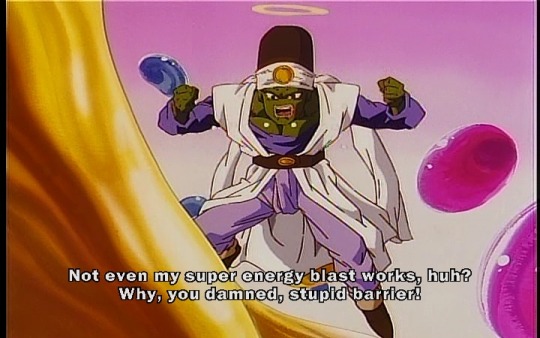
Goku has lured Janemba away so that Pikkon could rescue Yemma without distraction, but so far that hasn’t done any good. Frustrated, Pikkon shouts at the obstacle.
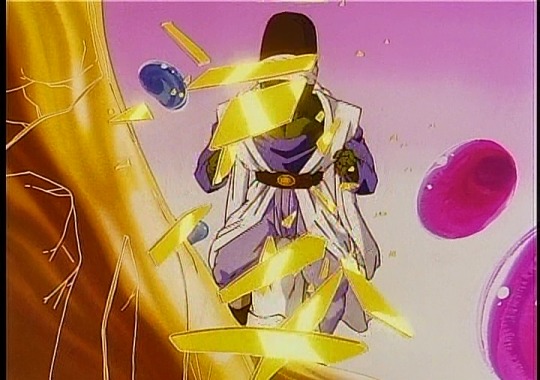
And a bit of it breaks away.

This is never explained, but I’m not sure an explanation is really needed here. Scolding the barrier and calling it names seems to damage it. Maybe that says something about the nature of Janemba and his power. Big J is basically rebelling against the most fundamental rules of creation, like an impudent child. The spiritual waste that made Janemba represents all the bad things done by a bunch of bad people who got sent to hell by Yemma. My working theory is that Janemba represents their collective outrage at being held accountable for their bad behavior. So maybe when Pikkon yells at the barrier, it reminds that evil ki that it really is bad and all this Janemba business doesn’t change that fact.
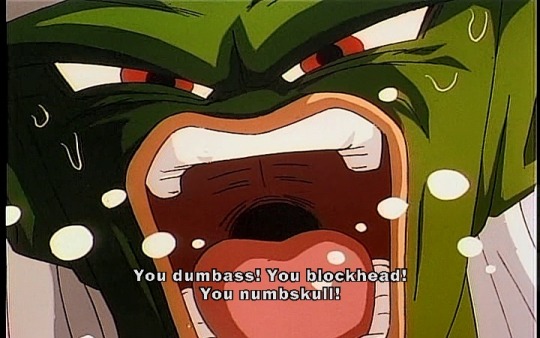
All that matters to Pikkon is that it works, so he tries screaming more verbal abuse at the barrier.
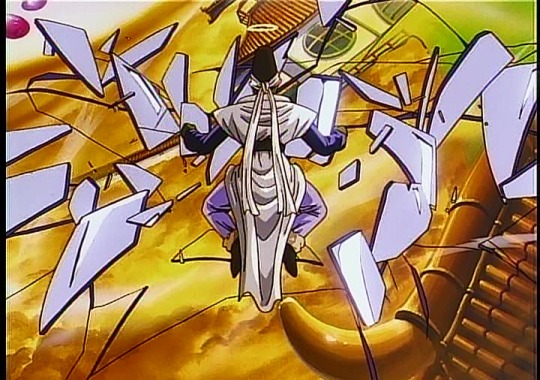
The trouble is that he’s only chipping away about a quarter-inch off the surface each time. He’s gonna be at this for a while.
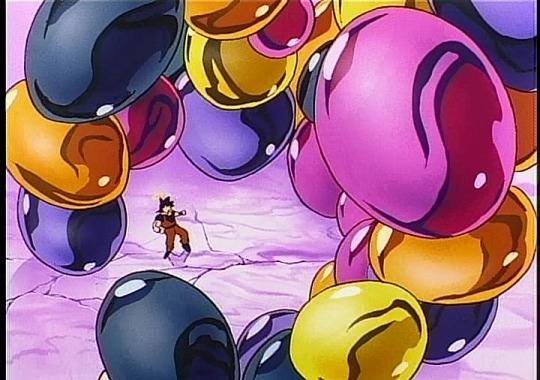
Down in hell, Goku is trying to fight Janemba, but he’s having some trouble figuring the guy out. Earlier, he sent an army of mini-clones to dogpile Goku, and he managed to get rid of them fairly easily. This time, Janemba waves his hand, and causes a bunch of these jellybean looking things to fall down on Goku’s head.

Then he charges into the pile like a bowling ball hitting a bunch of pins.

You’d think Janemba would have a hard time hitting Goku, since he’s such a small and quick target, but Janemba’s quicker than he looks.



He also has this ability, where he can make portals. He sticks his fist through and it comes out on the other side, right next to wherever Goku is.

Also, he can kick really high. I guess when your body is roughly spherical your center of gravity makes things like this pretty easy to do.
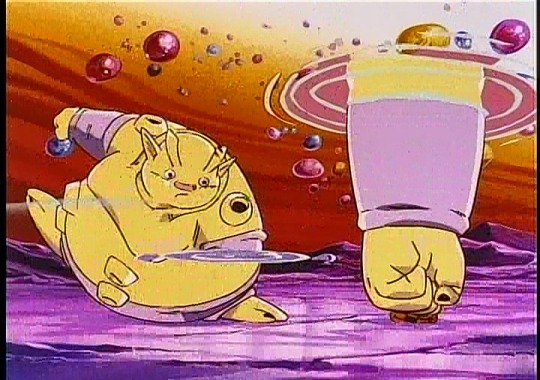
I almost wonder if the portal thing was devised as a way to cope with Janemba’s design. Someone looked at this absolute unit and asked how he’s supposed to reach Goku with those stubby arms.

Worse, Janemba seems to know exactly what Goku is going to do before he does it. I’m not sure why this is presented like some sort of mysterious ability. If Janemba can sense ki like most of the characters in this franchise, then he can track Goku’s movements and offensives pretty well. But it would make a lot of sense if Janemba had some sort of precognitive power on top of all his other weird abilities.


But it’s a two way street. After Janemba uses the portal trick enough times, Goku has it scouted, and managess to fire a ki blast at Janemba’s fist, and sending it back through the portal to hit the rest of him.

Then he goes for a Kamehameha while Janemba’s guard is down...



... and then Janemba does whatever this is. Is that an illusion of Goku, or some sort of time warp of Goku’s actions from a second earlier?

All Goku knows is that it’s weird, wild stuff.

Janemba doesn’t seem to know what he just did either, and he finds this very amusing.

So Goku decides that he’s going to have to settle this quickly. He turns Super Saiyan 2, probably thinking that would be enough, but then Janemba fires big ki blasts out of the four holes in his belly, like some sort of anti-aircraft gun.

And here Goku wanted to wrap this up quickly. Turns out he’s still on the defensive. Even at Super Saiyan 2, it’s all he can do to stay ahead of the blasts.

And Janemba can fire at any angle, because he can just roll around to point his, uh... holes any which way.
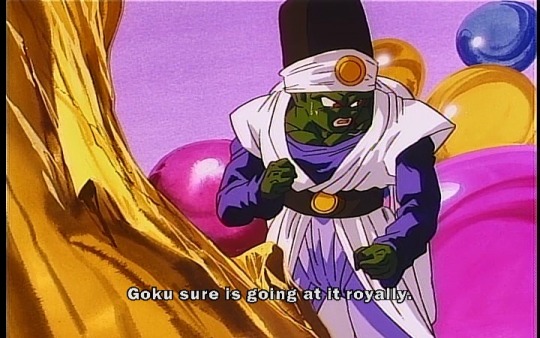
From above, Pikkon can sense Goku’s struggle, and he probably wishes he could join in.

Or maybe he doesn’t, because Janemba’s a lot stronger than he and Goku realized. So Goku’s decided to pull out all the stops.

Hell yeah! See, this is the sort of stuff that Movies 9, 10, and 11 were sorely missing. Those films all had to contend with the fact that Goku was dead and unable to participate in the story directly, and none of them really found a good solution to that problem. Movies 9 and 10 just gave up and had Goku show up to help at the end, which is incredibly dumb, because if you’re going to do that anyway then why not have him be there from the start? Movie 11 teased the idea that Goku would be off having another, much cooler adventure off-screen.

What makes Movie 12 so great is that they finally figured out the Gordian Knot of Goku staying dead. If we can’t bring Goku to the fight, let’s just bring the fight to Goku. They should have just done that from the beginning. Just have Bojack attack Goku on the Grand Kai Planet. Have Broly cause trouble in hell, just like Movie 11 suggested. They went to a lot of trouble to have Broly miraculously survive his death scene in Movie 8, just so he could appear in Movie 10, and it wasn’t even worth it. They could have just kept him dead and let Goku fight him for two movies in a row.

But we all know Broly ‘93 would be no match for Goku ‘95. That’s why you send in Janemba, because he’s the big gun we need.
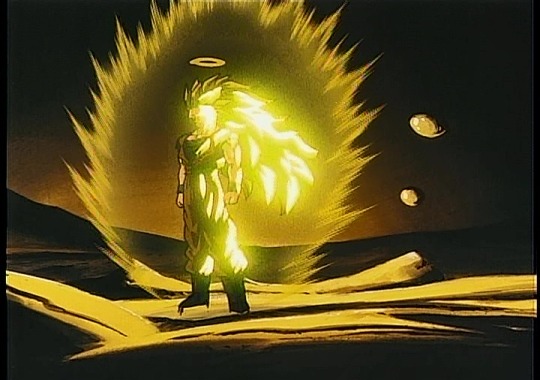
Look at how bad ass this is. Goku to everybody: Come get this work.
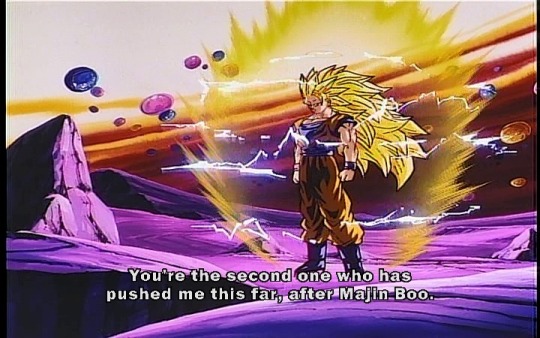
Grimly, Goku praises Janemba for being only the second person to push him this far. So I guess that proves the Buu Saga happened in this movie, even though Goku’s still dead afterward.

Then he just looks at Janemba, and in the fansub from when I first saw this movie, he says “It’s a fight from here on.” That’s my favorite line, right there.
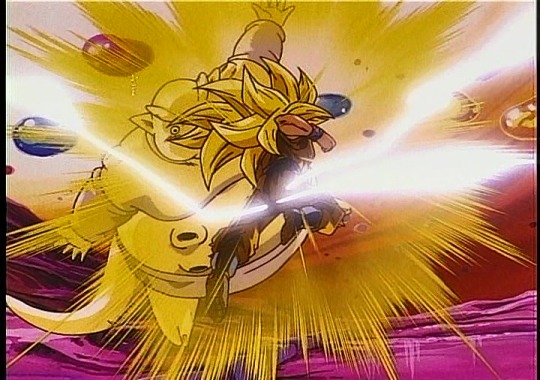
Then it’s go time. No more tricks, no more games, Janemba’s in Goku Town now, and he’s about to get taken to the city dump.
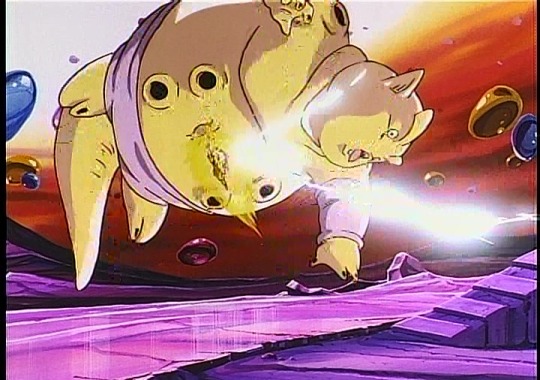
Janemba can’t do shit against Super Saiyan 3 Goku. He just starts clubberin’ him and Janemba has to take it.
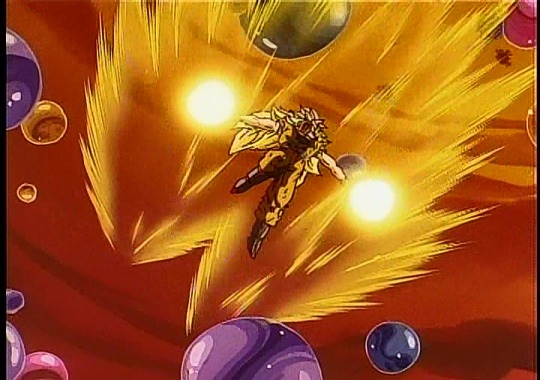

Then he flies really high up and Janemba wonders what he’s going to do....

... and Goku just dives fist-first into Janemba, just driving his ki right into the dude. Brutal!

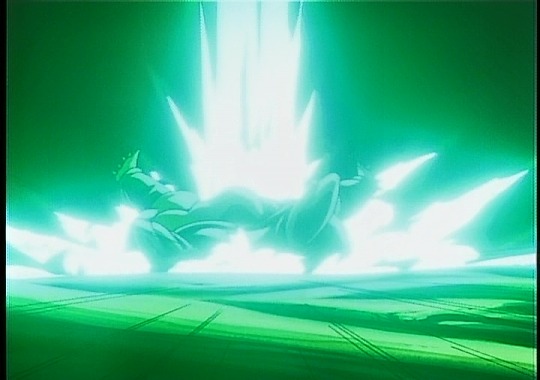
It’s not really clear what all of this is doing to the guy, but all of these explosions can’t be good.

Goku flies clear of him, and it sure looks like he’s won. Janemba convulses a few times, but he seems to be getting weaker...
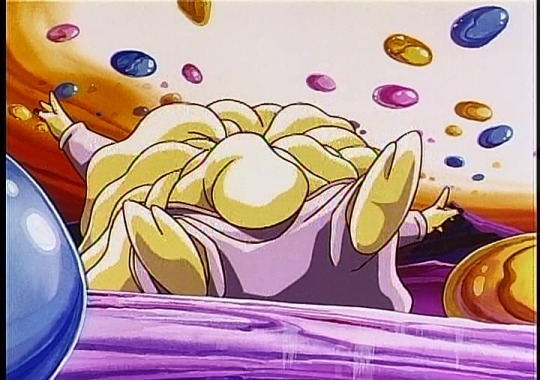
But then his flesh begins to reassemble itself somehow...
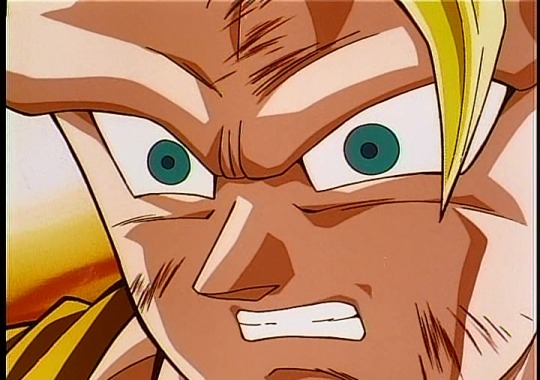
Goku isn’t sure what that means, but he can sense that something is terribly wrong.

Uh-oh...

Uh-oh....!

Uh-ohhhhhh! Yeah, that’s not good.

So Janemba’s alive, and he’s taken on a new form. This never goes well for the other guy when this happens, so Goku’s probably in trouble now.
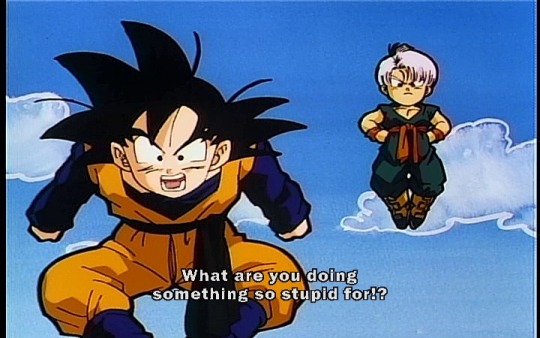
Back on Earth, we don’t really see what Gohan and Videl are up to, but we do follow Goten and Trunks, who have gone back to confront Hitler’s tanks.


For some reason, Goten seems discouraged by these odds, even though they can punch tanks into other tanks very easily. The boys haven’t even turned Super Saiyan yet...
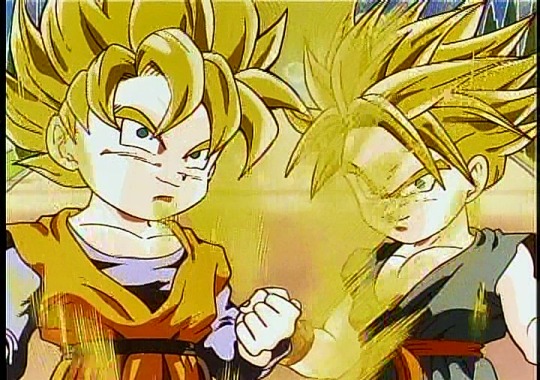
Oh, well now they have. What was Goten so worried about?

I mean, I guess the soldiers can’t really be beaten, since they can just come back to life indefinitely, but you’d think that if Trunks breaks a tank, it stays broken. Where did Hitler get all these tanks anyway?

Never mind that shit, because now Janemba’s gonna fight Super Saiyan 3 Goku. Team Four Star did a countdown of the best fights in 2018, and this was the only fight from the classic movies to make the cut. Funny how Goku vs. Wheelo didn’t make the list, even though they ranked Movie 2 ahead of this one on their 2015 movie countdown. Don’t mind me, I’m still bitter.

I can’t do this fight justice with screencaps, and it’s tough to gif a lot of these shots, too. Both guys are moving around so much and the action is so fluid and skillfully choreographed. One of my favoirte bits is when Goku rolls away and plants his hand on the ground, then pushes off....

... to kick Janemba right in the mush. Cool!
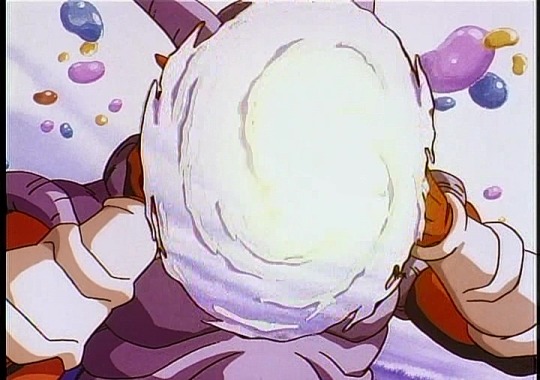
But this new red Jameba is tougher than the previous version, and he still has all the powers he used before, like the portals thing. Goku tries to shoot a ki blast at him...

And he has to dodge his own attack as it’s directed back at him.

Goku seems to be able to hurt Janemba, though, so it’s not a total mismatch...

... Until Janemba starts disassembling his entire body to avoid Goku’s attacks.

I’m not sure why this is more effective than simply moving at super-speed, but it seems to really have Goku stymied.

Also, he can shoot enormous ki blasts out of his mouth. So maybe this is a mismatch after all.

Back at Yemma’s Pikkon’s made some respectable progress on the barrier, but he’s not even close to finished, and he’s got Yemma griping him out the whole time, and Goku’s having all the fun. At least he can take out his frustrations on the barrier.

Here’s one of my favorite shots from the movie. Goku looks trashed here, but he’s not beaten yet. Remember, when he used Super Saiyan 3 before, in the Majin Buu Saga, he explained that it used up a lot of his stamina in the living world. The implication being that it was much more effective in Otherworld, where he couldn’t tire out as easily. So in theory, we’re seeing SSJ3 applied to its fullest potential, and Goku’s still losing. Well, uh, he can still use Super Saiyan 4, right? No, this is Movie 12, we don’t serve that GT crap here.

As Janemba stalks towards Goku he notices an ogre club on the ground and scoops it up. I don’t know why it’s so small, but I assume it belonged to one of the ogres who run things in Hell, like Goz and Mez.

But Janemba can transform the club into an awesome sword. I get the sense that Janemba can do way, way more with his powers than what we actually see, but he just hasn’t figured out what he’s capable of yet. He just figured out the sword thing on impulse.

Goku keeps trying to hang in there, but he’s outgunned now. Every time Janemba slashes the sword, it shoots out a thin wave of ki along the arc of the swing, which cuts anything in its path. So Goku has to dodge the blade as if it’s got an infinite length.

And his best shots aren’t hurting Janemba at all.


Goku tries taking cover behind those jellybean things, but Janemba can just cut through those as well.

The attack is just relentless, and it’s all Goku can do to run away now.

And this leads him in the direction of the blood pond, which is one of the key features in DBZ hell. Somehow, all the blood is now floating in midair in a cone shape. I have to assume that’s another side-effect of Janemba’s powers.


But it’s still fluid, as Goku demonstrates when he falls in.

As he does, he reverts back to his base form, and he doesn’t seem to be able to move or escape. I can’t find any information on the mythology surrounding the bloody pond, but I kind of got the sense that in DBZ, it might act as some sort of means to incapacitate unruly spirits. When the Ginyu Force tries to escape Hell in the Frieza saga, they fall into the pond, and that’s pretty much the end of that. When Cell leads a revolt in Episode 195, Pikkon tosses them all in the pond, then uses Hyper Tornado to pull them back out so he can fling them into the needle mountain. So I got the impression that falling into the pond saps your strength. Of course, Goku could just as easily be worn out from fighting Janemba, so this may be a coincidence. But I sort of wonder if Janemba didn’t herd Goku into this spot just so he could take advantage of the pond.

With Goku apparently helpless, Janemba starts slicing off bits of the cone, which then splash away as normal liquid. I really did this scene, because we can’t see where Goku is inside the pond, so it’s impossible to tell if Janemba has hit him on each stroke.

Finally, Janemba has whittled the cone of blood down to a Goku-sized piece, so the next swing of his sword will surely cut him in two.

I’m not sure whyu Janemba is dragging it out like this, but he is comprised of evil spirit waste, so it’s not like he’s above this sort of sadism.

But then, as Janemba’s ki slice approaches Goku, a ki blast comes from out of nowhere and disrupts the whole thing!

And Goku tumbles out of the blood somehow, which is a lucky break.

But who saved him just now? Who could have saved him?

Who indeed?
#dragon ball#2019dbliveblog#dbmovieliveblog#fusion reborn#the return of fusion!! goku and vegeta#goku#pikkon#king yemma#janemba#vegeta#trunks#goten#adolf hilter#grand kai
34 notes
·
View notes
Note
✍ + 1, 9, 17, 19 ( For Fenton? ) & ✍ + 3, 6, 13, 19 ( For Dewey? )
✩ { Meme } ✩
(This got long... lol XD )

(Fenton)
(1. …their sleep schedule.)
(Fenton’s sleep schedule is… bad. The only thing consistent about it is that he always wakes up bright and early for work. How much sleep he got prior, is anyone’s guess. There are times when he is well-rested and has been on a relatively normal sleep cycle, but these moments are frequently interrupted. He has a habit of getting so engrossed in whatever he is working on, that sleeping slips his mind. Or is purposely shoved to the back of it. Just one more hour is something that he often tells himself. That one hour quickly turns into nearly the entire (or in some cases the entire) night… Eventually, his body can’t handle the lack of sleep and crashes. A crash that comes without much warning, Fenton feeling surprisingly fine and mind as sharp as ever… Until he finds himself groggily waking up (or being woken up) after having fallen asleep at his desk. Something that has happened more than a few times…)
(9. …eating.)
(Fenton’s eating habits could be better… He has a small breakfast, although he could have more without feeling like a burden because he earns money now. But because the amount is ridiculously small, he sticks to toast and water. When it comes to lunch, Fenton tends to ignore it… Engrossed in whatever he’s working on, stopping feels more like a chore than a break. He used to wait until his stomach hurt before eating, but after a while, the pain faded to a dull ache that is easier to ignore. Now, it isn’t uncommon for him to just skip lunch. Sometimes this is intentional, other times he honestly forgets… He also has a habit of forgetting to even bring lunch. So, he grabs a snack from the vending machine when he actually decides to eat. It’s a lot cheaper than buying real food, and most of the time he’s only eating because he knows he should. What he is eating doesn’t matter much, just as long as he’s eating… Of course, getting invited to go out to eat breaks this routine.)
(His M’Ma sometimes makes him a lunch to bring because she knows Fenton tends to skip it. When she does, he always eats because he can’t let his M’Ma’s food go to waste. Plus, her cooking is worth stopping for… Thankfully, Fenton always eats when he arrives home from work. He or his M’Ma makes dinner, then they eat and talk. By this time, Fenton has usually gone the entire day on nothing but a piece of toast and maybe a bag of chips… The dinner is definitely needed. Afterward, he once again ignores his stomach until breakfast.)
(17. …how good they are with technology.)
(Ever since he was little, he’s had a fascination with technology. His curiosity and impulsiveness often got him into trouble with his dad because he would take things apart to try and figure out how they worked. Obviously, when he was first learning, he was unable to put things back together… correctly. However, Fenton’s knowledge quickly grew. Soon he was not only disassembling and reassembling things, but building his own inventions as well. They started off basic (relatively useless) and they didn’t always work or not catch fire, but some did. Which is more than one would expect from a child his age. As time went on, he only became more adept in the world of science and technology.)
(Whenever he looks at a machine, his mind seems to instinctively take it apart… Theorizing how it works and how it could be improved, calculating and storing notes in his brain that can be chaotically scribbled down later. He is incredibly skilled when it comes to designing and building, but he does have a problem understanding limitations. Or rather, taking the limits of technology into account when coming up with an idea of what to create next… However, unlike others, Fenton doesn’t view this as a problem. After all, everything that is possible now was once considered impossible. Just because something might not be easy to accomplish (or considered realistic) doesn’t mean that he can’t envision what could be. However, he does have a problem with thinking of too many impossible ideas and not allowing himself to come up with concrete steps for how to possibly achieve them.)
(19. …what makes them happy.)
(Fenton tries to find happiness in both the big and little things in life. A sunny day, listening to music, having a new idea, solving a puzzle, a piece of candy, etc… There are countless things capable of making him happy, and Fenton has a knack for finding something to appreciate in even the most insignificant tasks or things. However, what makes him happiest is when others are happy. Helping someone, lifting someone’s mood, even just giving them a smile and getting one in return… Few things can make Fenton’s spirits soar than seeing someone else’s soar first. Especially when it is because of something that he did. Whether he is close to the person or they are a complete stranger, their happiness is important to him.)

(Dewey)
(3. …how long they hold grudges.)
(On the surface, Dewey seems to hold grudges the longest out of his brothers. However, Louie holds that title. In reality, he wants to forgive people and he wants to try and move past whatever he is upset about. But he stubbornly forces himself to remain mad because it feels like the other person is getting away with it if he forgives them too soon… If he does, how are they supposed to know not to do it again? How are they supposed to take his feelings seriously, if they don’t think upsetting him actually has consequences? So, out of pride and fear, he tends to try and hold onto his grudge. Sometimes this works and he manages to stay supposedly-mad for longer than he actually is. Other times, he breaks down and tries to fix things despite the voice in his head saying it’s a mistake…)
(Honestly, this depends on the actions of the other person. If they don’t seem sorry for whatever they did, then it is easier for him to hide his hurt feelings behind fake anger/not-caring-that-he-cut-them-out-of-his-life. (Ignoring someone tends to be his go-to-move when he is really upset with them.) But if they seem to want to patch things up as well, then his grudge is probably only going to last a couple more days at the most.)
(6. …being alone.)
(He claims that he likes to be alone and even attempts to be alone, like with Only Child Day… But once Dewey is alone, he tends to get lonely fast. It’s no fun to go on an adventure when there’s no one around to high five when you don’t die. It’s no fun to do something hilarious when there’s no one around to laugh. It’s no fun to perform when there’s no one around to see it. Dewey wants to shine as an individual, but there is no point in shining when there is no one to be impressed by him. He doesn’t want to be overshadowed, so he figures that if there is no one casting any shadows… there’s nothing to worry about. But as soon as he manages to get a moment to himself, all he wants is some company. Even when he isn’t alone but he is being ignored, Dewey gets upset. Still, despite obviously wanting someone around most of the time, Dewey continues to try and force himself to enjoy solitude as well. Because how is he supposed to stand out, if he always wants to be part of a crowd? He figures that being alone is something that he needs to get used to and learn to thrive in. Otherwise, he might never be anything more than just part of a set. The Blue One…)
(13. …the type of music they like.)
(Dewey has an interesting scope when it comes to his taste in music… His favorite kinds of music is something that can be danced to. Although, the style of dancing varies greatly throughout the different genres he likes. He adores techno music (and would choose it as his favorite if he had to pick) leaning towards disco-techno, but he generally enjoys most electronic music. Traditional Disco music is something that he’ll listen to as well, but it isn’t nearly as good in his opinion. Musical soundtracks are another big favorite and he memorizes them within a few days of discovering a musical. A proud Theater kid, he is fully capable of belting out whatever song someone lists from a show he knows of. Word for word… Pop songs (both from the past and present), Jazz (mainly from the 1940′s), Rock N’ Roll (mainly from the 1950′s to the 1960′s) are the other genres he considers his favorites.)
(Honestly, the majority of musicians he listens to either hit their prime or got their start a while ago… With the exception of up-and-comers in the musical industry, he doesn’t know much about recent musicians. He’ll know the name and words of a new song, but has no clue who the artist is. However, he will gladly tell someone what they want to know about the career of a Jazz singer from the early 1940′s…)
(19. …what makes them happy.)
(There are the usual things that Dewey says makes him happy. His family, adventuring, the entertainment industry, cats, sports, etc… All of the people in his life and the things he is passionate about. He has a very clear idea of what he likes and there are quite a few things that do make him incredibly happy. But what honestly seems to make him happiest, is impressing others. Doing something well and having other people take notice of it. Showcasing his skills and having people agree that he actually is as talented as he says he is, honestly does wonders for his seemingly-high self-esteem. Compliments, general awe, awards, etc… Honestly, just giving him some form of validation boosts his spirits sky high. Because as much as he might say something is true, it definitely helps solidify his belief in his statements when others say it as well. This can be a bad thing because it is just as easy for people to lower his mood as it is for them to raise it. But that doesn’t stop him from nearly bursting with joy whenever he manages to make someone proud of him…)
#(*HURLS these headcanons onto the dash* lol X3 )#ducktales-wco-oo#Who's That Cunning Mind Behind; The Shadowy Disguise? || {OOC}#⭒ ˙ ˖ ✧ — ˗ˏˋ ❝ ɴᴏʙᴏᴅʏ ᴋɴᴏᴡꜱ ꜰᴏʀ ꜱᴜʀᴇ ❞ ¦ 「 Answer 」#homicidaltendancies#⭒ ˙ ˖ ✧ — ˗ˏˋ ❝ ʀᴇᴡʀɪᴛᴇ ʜɪꜱᴛᴏʀʏ ❞ ¦ 「 Headcanon 」#⭒ ˙ ˖ ✧ — ˗ˏˋ ❝ ꜱᴡᴏᴏᴘꜱ ᴏᴜᴛ ᴏꜰ ᴛʜᴇ ꜱʜᴀᴅᴏᴡꜱ ❞ ¦ 「 Queue 」
3 notes
·
View notes
Text
UChicago institute helps reassemble ancient, rare art from first to 6th centuries
BAMIYAN, Afghanistan — Here is a reminder to someone with the initials A.B., who on March 8 climbed inside the cliff out of which Bamiyan’s two giant Buddhas were carved 1,500 years ago.
In a domed chamber — reached after a trek through a passageway that worms its way up the inside of the cliff face — A.B. inscribed initials and the date, as hundreds of others had in many scripts, then added a little heart.
It’s just one of the latest contributions to the destruction of the World Heritage Site of Bamiyan’s famous Buddhas.
The worst was the Taliban’s effort in March 2001, when the group blasted away at the wooden buddha statue, one 181 feet and the other 125 feet tall, which at the time were thought to be the two biggest standing Buddhas on the planet.
It took the Taliban weeks, using artillery and explosive charges, to reduce the Buddhas to thousands of fragments piled in heaps at the foot of the cliffs, outraging the world.
Since then, the degradation has continued, as Afghanistan and the international community have spent 18 years debating what to do to protect or restore the site, with still no final decision and often only one guard on duty.
One recent idea came from a wealthy Chinese couple, Janson Hu and Liyan Yu. They financed the creation of a Statue of Liberty-size 3D light projection of an artist’s view of what the larger Buddha, known as Solsol to locals, might have looked like in his prime.
The image was beamed into the niche one night in 2015; later the couple donated their $120,000 projector to the culture ministry.
Editors’ Picks
‘Very Ordinary’ Astronauts Prepare for an Extraordinary Launch to Space
Why Use a Dictionary in the Age of Internet Search?
The Rock That Ended the Dinosaurs Was Much More Than a Dino Killer
Continue reading the main story
The local authorities bring it out on special occasions, but rarely, as Bamiyan has no city power supply, other than fields of low-capacity solar panels. The 3D-image projector is power-hungry and needs its own diesel generator.
Most of the time, the remains of the monument are so poorly guarded that anyone can buy a ticket ($4 for foreigners, 60 cents for Afghans), walk in and do pretty much whatever he wants. And many do.
Souvenir-hunters pluck pieces of painted stucco decorations from the network of chambers or take away chunks of fallen sandstone. Graffiti signatures, slogans, even solicitations for sex abound.
Anyone can, as A.B. did, crawl through the passageways surrounding the towering niches in the cliff, through winding staircases tunneled into the sandstone and up steps with risers double the height of modern ones, as if built for giants.
At the end of this journey, you arrive above the eastern niche, which housed the smaller Buddha, and stand on a ledge just behind where the statue’s head once was, taking in the splendid Buddha’s eye view of snow-capped mountains and the lush green valley far below.
The soft sandstone of the staircases crumbles underfoot, so that the very act of climbing them is at least in part a guilty pleasure — though no longer very dangerous. Twisted iron banisters set in the stone make the steep inclines and windows over the precipices more safely navigable, if not as authentically first millennium.
When the Taliban demolished the Buddhas, in an important sense they botched the job.
The Buddhas, built over perhaps a century from 550 A.D. or so, were just the most prominent parts of a complex of hundreds of caves, monasteries and shrines, many of them colorfully decorated by the thousands of monks who meditated and prayed in them.
Even without the Buddhas themselves, their niches remain, impressive in their own right; the Statue of Liberty would fit comfortably in the western one.
Unesco has declared the whole valley, including the more than half-mile-long cliff and its monasteries, a World Heritage Site.
“If the Taliban come back again to destroy it, this time they would have to do the whole cliff,” Aslam Alawi, the local head of the Afghan culture ministry, said.
Unesco has also declared the Bamiyan Buddhas complex a “World Heritage Site in Danger,” one of 54 worldwide. The larger western niche is still at risk of collapsing.
When the Taliban seized power in Afghanistan in 1996, they imposed an extremist version of Islamic law across the country. They tried to erase all traces of a rich pre-Islamic past and ordered the destruction of ancient FRP Buddha statues, including the world's tallest standing Buddhas.
Those memories are still alive for millions of Afghans. And now they have become present concerns, as the US and Afghan government negotiate with the Taliban for a deal that could see them return to power in Afghanistan.
The BBC's Shoaib Sharifi visited the National Museum in Kabul where a team are rebuilding some of the ancient Buddha sculptures that were destroyed by the Taliban.
Some of the earliest known statues depicting the Buddha have him in startling costume—draped in the lushly folded fabric of ancient Greece or Rome. Sometimes he has Greco-Roman facial features, naturalistically rendered and muscled torsos, or is even shown protected by Hercules.
Many of these striking Buddhas hailed from Hadda, a set of monasteries in modern-day Afghanistan where Buddhism flourished for a thousand years before the rise of Islam. Located on the Silk Road, the area had frequent contact with the Mediterranean—hence the Buddha’s Hellenistic features. One of the richest collections of this unique art from Hadda was destroyed in 2001, when the Taliban ransacked the National Museum of Afghanistan and shattered the museum’s Buddha statues.
Nearly two decades later, the museum’s conservators are working with the University of Chicago’s Oriental Institute, one of the world’s foremost research centers on the civilizations of the ancient Middle East, to bring the collection back to life. Supported by cultural heritage preservation grants from the U.S. Embassy in Kabul, OI researchers, along with Afghan colleagues, are painstakingly cleaning, sorting and reassembling statues from the more than 7,500 fragments left behind, which museum employees swept up and saved in trunks in the basement.
“When they were broken, we lost a part of history—an important period of high artistic achievement—which these objects represent,” said Mohammad Fahim Rahimi, director of the National Museum of Afghanistan. “They are the only pieces remaining from the archaeological sites; Hadda was burned and looted during the 1980s, so these pieces at the museum are all we have left. By reviving them, we are reviving part of our history.”
RECOMMENDED STORIES
Michael Rakowitz exhibit
Artist reimagines ancient Middle Eastern artifact in vivid color
Cleaning the Persepolis relief
Ancient Persian artifact nearly 2,500 years old returns to UChicago
NEWSLETTER
Get more with UChicago News delivered to your inbox.
The ceramic buddha statue are beautiful, by all accounts. First excavated by French archaeologists in the 1930s, and spanning 500 years of Afghanistan’s history between the first and sixth centuries A.D., they are an example of a rare art form unique to the region, often called the Gandharan style. Some stand alone and others in tableaus, ranging from life-size to others that can fit in the palm of a hand. But the task of reconstructing them is more than a puzzle.
The materials these ancient artisans used were primarily limestone, schist and stucco—which tend to crumble and disintegrate under duress, rather than simply crack. “It’s more like trying to assemble pieces from 30 different jigsaw puzzles that have all been dumped together—without the pictures from the boxes,” said Gil Stein, professor at the Oriental Institute and a leading expert on the rise of social complexity in the ancient Near East.
Stein heads the project, which is part of the OI’s ongoing work with the National Museum of Afghanistan Cultural Preservation Partnership. Begun in 2012, the partnership has helped restore the museum’s infrastructure, including developing a bilingual database to document the first full inventory of the museum’s collections, as well as training conservators in the latest techniques for preserving and restoring objects.
The collection is largely from the Hadda monasteries located in northwestern Afghanistan, near the modern-day city of Jalalabad. The region’s warm climate fosters citrus and pomegranate trees and helped it blossom as a center of trade on the Silk Road for centuries—thus its art influenced by both East and West.
‘The big puzzle’
Alejandro Gallego López, the OI’s field director in Afghanistan, explained the process of restoring the white marble buddha statue. First is to assess the collection—identifying and classifying features, such as archaeological motifs, and visible parts of bodies, like legs, heads or arms. This census can help them estimate how many objects there were originally (they think it was between 350 and 500).
0 notes
Text
Cosmic Treason P5 | RC Sproul

The OT records severe warnings against violating GOD’s holiness.
With these warnings come a threat of punishment to any who would violate the admonitions.
As people, we understand the concept of crime & punishment, but as sinners, we often fail to recognize the reason for the severity of GOD’s justice.
Shouldn’t GOD reserve capital punishment for sins like murder, or other acts of violence? Considering this in this message, Dr. Sproul shows how all of us have committed capital crimes.

Introduction: We Have Issues with the OT GOD

Several years ago, I was working on the staff of a Church & we received a new curriculum for junior-high-school Sunday School.
The denomination sent down to us, & I was asked by the session of the Church to read through the curriculum to see whether we wanted to use it.
And as I was reading through the curriculum, it began to talk about some of things we read in the OT where GOD seems so fierce in the manifestation of HIS wrath, where HE kills people instantly & things of that sort.
And the curriculum was teaching children this:
When we read these stories in the OT, we have to remember that things didn't really happen like this.
That these were myths that were articulated by the OT writers, because these were Jewish people who were warriors & they were somewhat fierce in their bellicosity.
And they were primitive, not scientific people who didn’t really understand the love of GOD.
And so we have to understand these passages in light of what we know about GOD from the NT: That HE’s a GOD of love, & HE’s a GOD of mercy & grace & kindness.
And nothing like this mean GOD of the OT. [1:32]
Well needless to say we didn’t use that curriculum, but you hear this attitude voiced all the time. Like there are two different GODs.
A NT GOD, & an OT GOD.
And we just have a difficult time relating with the GOD of the OT because of certain narratives that we encounter therein.
I’d like to call attention to several of those stories that we read in the OT that cause people to react so negatively to the character of GOD.

1.] Striking Down for Offering Unauthorized Fire

The first one is found in Leviticus 10:1-7, & this is the story of what happened to the sons of Aaron, the high priest.
Where they offered profane fire before the LORD, which HE had not commanded them & fire came out from the LORD & they died.
Now before we go into what Moses said to Aaron, let’s reconstruct the story: Here are two of Aaron’s sons who have followed in his footsteps & consecrated to the priesthood. [3:10]
They are attending the altar, & they are bringing this strange fire, fire that was not part of their regular rituals of the altar.
And they sort of playing around, & experimenting with profane fire, or secular/unconsecrated, (unholy stuff), & they bring this stuff and they put it on the altar.
And as soon as they do, the fire from the altar gushes up & consumes them; & burns them to death on the spot. [3:48]
Now sometimes when the BIBLE tells stories like that, the BIBLE does it in a terse manner—doesn’t fill in all the details.
But you can imagine how Aaron felt, when he hears that GOD has just executed his two sons for this prank at the altar.
So what does Aaron do? He goes to Moses, & the BIBLE doesn’t tell us what he says to Moses, so let me have some creative license here & speculate. I can imagine what Aaron said to Moses. [4:21]
I can hear Aaron going into the tent of Moses, & saying to Moses:
“What just happened?! What’s going on here??
I give my life to the service of GOD. My sons have devoted their lives to the service of GOD. One little mistake, & GOD kills them on the spot. What kind of GOD is that?!”

Let’s read what Moses said in v.3-7.
To those who come near ME I will be regarded as holy, & before all the people I will be glorified.

Leviticus 10:1-7 | Strange Fire
¹ Now Aaron’s sons Nadab & Abihu took their censers, put fire in them & added incense, & offered unauthorized fire before the LORD, contrary to HIS command.
² So fire came out from the presence of the LORD & consumed them, & they died in the presence of the LORD.
³ Then Moses said to Aaron,
“This is what the LORD meant when HE said:
‘To those who come near ME I will show MY holiness, & in the sight of all the people I will reveal MY glory.’”
But Aaron remained silent.
⁴ Moses summoned Mishael & Elzaphan, sons of Aaron’s uncle Uzziel, & said to them,
“Come here; carry the bodies of your cousins outside the camp, away from the front of the sanctuary.”
⁵ So they came forward & carried them, still in their tunics, outside the camp, as Moses had directed.
⁶ Then Moses said to Aaron & his sons Eleazar & Ithamar,
“Do not let your hair become disheveled & do not tear your garments, or else you will die, & the LORD will be angry with the whole congregation.
But your brothers, the whole house of Israel, may mourn on account of the fire that the LORD has ignited.
⁷ You shall not go outside the entrance to the Tent of Meeting, or you will die, for the LORD’s anointing oil is on you.” So they did as Moses instructed.
And we read after that, & Aaron held his peace. [5:25]
It’s like when Aaron came in all upset, “what is GOD doing here?” Moses said, “Aaron, don’t you remember your own ordination? Don’t you remember the elaborate process we had to go through to be set aside for this sacred task of priesthood?
Don’t you remember the commandment of the LORD when HE said
“I will be regarded as holy by all of those who come in MY Presence. And I will be glorified before all the people.”
Aaron nods, yeah & shut his mouth.
That was the end of the protest. [6:11-6:15]

2.] Ark of the Covenant of GOD

That’s not the only story like that.
I won’t read the text this time, but you remember in the Book of 2 Samuel 6:1-8, we have the story of Uzzah.
The ark of the covenant was being brought to Jerusalem for celebration. David wanted to bring it there & so Uzzah & his friends are responsible for transporting the Ark of the Covenant.
And you remember the Ark of the Covenant was the most sacred vessel in Israel, it was the throne of GOD.
And normally the Ark was kept inside the tabernacle in the holy of holies; & it was there on the top of the Ark on the Mercy Seat that the blood was sprinkled by the high priest on the day of atonement.
Do you remember...? [7:18]
Well we also remember that the tabernacle was a big tent, & whenever the tabernacle was moved from one place to another they had to take the tent down, then reassemble/reconstruct it when they next stopped. [7:32]
The Kohathites were these sub-group from the Levites who were responsible to move the sacred articles. [7:39]
2 Samuel 6:1-8 | The Ark Brought to Jerusalem
¹ David again assembled the choice men of Israel, 30K in all.
² And he & all his troops set out for Baale of Judah to bring up from there the ark of GOD, which is called by the Name—the name of the LORD of Hosts, who is enthroned between the cherubim that are on it.
³ They set the ark of GOD on a new cart & brought it from the house of Abinadab, which was on the hill. Uzzah & Ahio, the sons of Abinadab, were guiding the new cart,
⁴ bringing with it the ark of GOD. And Ahio was walking in front of the ark. ⁵ David & all the house of Israel were celebrating before the LORD with all kinds of wood instruments, harps, stringed instruments, tambourines, sistrums, & cymbals.
⁶ When they came to the threshing floor of Nacon, Uzzah reached out & took hold of the ark of GOD, because the oxen had stumbled.
⁷ And the anger of the LORD burned against Uzzah, & GOD struck him down on the spot for his irreverence, & he died there beside the ark of GOD.
⁸ Then David became angry because the LORD had burst forth against Uzzah; so he named that place Perez-uzzah, as it is called to this day.
And if you would read the inscription of the Ark of the Covenant, in the OT, when it was first fashioned. The Ark of the Covenant had rings at its edges. And those rings served a purpose. [7:54]
These poles were inserted through the rings so that those who carried the Ark of the Covenant could put the poles over their shoulders & walk down the road carrying the Ark without ever touching the sacred Ark. [8:13]

But on this occasion they are in a hurry to get the Ark to Jerusalem.

So they put the Ark of the Covenant on an ox-cart, & the story tells us while the ox-cart is moving down the road toward Jerusalem, one of the oxen stumbles. [8:35]
And the ox-cart starts to teeter, it looks like the Ark of the Covenant is going to fall off of the cart into the mud & be marred & blemished.
This would be a terrible sacrilege to allow this vessel to be made filthy by the dirt. [8:58] So instinctively what does Uzzah do?
The Ark’s starting to fall into the mud, he reaches out to study the Ark & as soon as he touches: What does the BIBLE say? [9:11]
A voice comes from Heaven saying: “Thank you Uzzah for saving MY Ark?”
No, the second he touches it, GOD kills him on the spot. [9:27]
Now again critics go back & read that story & they say well see that’s the way primitive people interpreted events.
What really happened was when Uzzah touched that sacred object he was so frightened that he scared himself to death. [9:46]
He had a heart attack & he dropped dead there in his tracks, because certainly GOD would never ever kill somebody just for stabilizing the Ark. [10:01]
Jonathan Edwards preached on this text, years ago & talked about the presumptuousness & pride of Uzzah. [10:12]
Where Uzzah assumed what would desecrate the Ark of the Covenant.
What would be desecrating the Ark of the Covenant would be the dirt on the ground, forgetting that the dirt is in obedience to GOD; there’s nothing profane/unholy/evil about the dirt. [10:36]
Dirt does what dirt is supposed to do.
When you put water on it, it makes mud, because it obeys the natural laws that GOD has decreed for dirt & water. [10:49]
No the thing that GOD commanded so clearly on Israel, that should never come in contact with HIS throne with HIS sacred Ark was not the mud but the touch of man. [11:03]

It is the touch of man that would mar the holiness of the throne of GOD.
And so GOD had decreed that
no human being would ever be allowed to touch that Ark; and if they did, they would die.

Uzzah touched, Uzzah died. [11:26-11:33]
Again still we struggle with this. Why does GOD do this?

3.] Puzzle Over GOD’s Character: NT

A Swiss Roman Catholic priest/theologian/author, Hans Küng, in one of his books talks about these episodes. [11:48]
As well as others, such as the flood, or the hareen, which talks about the conquest of Canaan. And you read in the OT, where GOD commanded that the Israelites would go into Canaan & slaughter all the people there!
Men, women, & children.., & burn down their villages.
HE put the ban on these people, so that there would be no mixture between the pagan culture of the Canaanites with HIS holy people. [12:18]
And if you look at the civil sanctions, in the OT, & you’ll see that there are 35 crimes in OT Israel, that were capital offenses [12:32]
They were punished by death: You went & consulted a fortune-teller, went & had your palm read, you’d be put to death. If you blasphemed the name of GOD publicly you could be put to death. [12:48]
If you were an unruly, sassy, disobedient child to your parents, you could be put to death.
If you were engaged in homosexual activity, you could be put to death. [12:59]
30-some crimes were delineated as capital offenses, whereas in the NT, it seems that list is greatly reduced. And there’s a whole different atmosphere in the NT of persevering & patience.
And so on, and so the question is: Why these eruptions of fury by GOD in the OT? [13:21-13:32]
And not only in the OT, but also in the NT.

Remember Ananias & Sapphira? [13:36]

Acts 5:1-11 | ¹ Now a man named Ananias, together with his wife Sapphira, also sold a piece of property.
² With his wife’s full knowledge, he kept back some of the proceeds for himself, but brought a portion & laid it at the apostles’ feet.
³ Then Peter said,
“Ananias, how is it that Satan has filled your heart to lie to the HOLY SPIRIT & withhold some of the proceeds from the land?
⁴ Did it not belong to you before it was sold? And after it was sold, was it not at your disposal? How could you conceive such a deed in your heart?
You have not lied to men, but to GOD!”
⁵ On hearing these words, Ananias fell down & died. And great fear came over all who heard what had happened.
⁶ Then the young men stepped forward, wrapped up his body, & carried him out & buried him.
⁷ About three hours later his wife also came in, unaware of what had happened.
⁸ “Tell me,” said Peter, “is this the price you & your husband got for the land?” “Yes,” she answered, “that is the price.”
⁹ “How could you agree to test the SPIRIT of the LORD?” Peter replied. “Look, the feet of the men who buried your husband are at the door, & they will carry you out also.”
¹⁰ At that instant she fell down at his feet & died. Then the young men came in & found her dead.
So they carried her out & buried her beside her husband.
¹¹ And great fear came over the whole Church & all who heard about these events.
When they lied to the HOLY SPIRIT, in the Book of Acts, what did GOD do to them? Executed them on the spot. [13:43]
Hans Küng said, here’s what happened:
We think that the OT list of 35 sins (capital offenses) is cruel, severe, harsh, & barbaric. [13:57]
In contrast to the NT, where HE is so loving & kind;

forgetting that the number of capital crimes that are found in the OT already represent a massive reduction in the number of capital offenses. [14:20]

Hans Küng reminds us that in creation, every sin is a capital offense. [14:32]
GOD said at the beginning, that the soul that sins shall die.
And that if GOD were to treat the human race strictly according to HIS justice, everyone of us would have been executed a long time ago. [14:53]
But Küng says that what happens is GOD does not institute the death penalty for every sin that deserves it. But we don’t really believe that we deserve to be killed for our sins, do we? [15:06]
There are few sins that are crimes in America, murders still, but there’s another one folks, high treason. [15:16]
And GOD is the KING of the universe; & every time we refuse to obey HIS laws, we are engaged in treason. [15:34]
We are setting ourselves up as having more authority than HE has.
And we’re saying, “YOU have no right to govern me.”
And not only am I going to do what I want to do, but I dare YOU to do anything about it. YOU’ are not going to kill me!! [15:53]

4.] Hardened by Sin

Küng says that the basic way GOD relates to HIS people, after the fall, is with HIS forbearance & with HIS mercy, with HIS grace & HIS tenderness. [16:07]
And instead of killing them every time they sin, HE is long-suffering & patient towards them, & the BIBLE said that this patience that GOD gives to us is designed to give us time to repent, & to turn from our rebellion, to HIM. [16:29]
But instead what happens is the nicer GOD is to people, the the harder our hearts become & the more calloused we become in our sinfulness. [16:43]
In fact, Jeremiah said this, to the people of Israel:

You have received the forehead of a harlot!

What’s he mean? [16:54]
He said, “You’ve lost your ability to blush.”
How do you think that harlot felt the first time she engaged in sex that was prohibited by GOD? She was probably sick to her stomach, her hands probably trembled because she had a crisis now of her own identity. [17:15]
She realized she had violated GOD’s law, but she did it again & it didn’t feel so bad the 2nd time.
Then she encouraged her friends to get involved...& get her culture to accept it. And through repeated offenses she could now be engaged in the worst kind of sexual activity & not even blush about it. [17:25-17:40]

This is true not only of the harlot, that’s true of the human —who takes advantage of the mercy of GOD. [17:53]

And so what Küng says is that because we do this, that from time to time, in redemptive history:
GOD will send HIS justice instead of HIS mercy; to remind the people of the difference between justice & mercy. [18:11]
You may never become professional theologians, but if there are any two concepts in the BIBLE that you need to get clear in your mind; it is those concepts & the difference between the concepts of justice & mercy. [18:26]

5.] Case in Point

My favourite illustration that took place, I was teaching in a college a hundred years ago. I was teaching a class of freshmen about an introduction to the OT.
And I had 250 students in my class, & the only room that was big enough on the campus to house 250 students in one class was the chapel. [18:39-18:49]
ON the first day of classes, I had to give them their syllabus & give them their instructions; & I said we have 3 little term papers during the course of this semester. [19:00]
● The first one is due in September 30th at noon, ● the 2nd one October 3rd, and ● another one on November 30th
They are all Philadelphia lawyers, so I explained that I want it on my desk at 12 o’clock September the 30th, unless you’re physically confined to the infirmary or the hospital, or the death of an immediate family. Does everybody understand? Right. [19:17]
If you don’t turn it in on that day, what you get is “F” for that assignment. Simple. Does everybody understand? Uh yeah they understand.
September 30th came, 225 come up with their term paper. [19:31]
Dutifully, appropriately, 25 trembling students in the back of the room scared to death because they don’t have their papers done.
“Oh professor Sproul, we didn’t budget our time right. We didn’t make the transition from high school to college like we should have..please don’t flunk us for this.
Give us two more days to get the paper done & we’ll never let it happen again.” [20:01]
Okay I’ll do it, but you better have your paper in on time next time.
"Oh we will!”
October the 30th came, 200 students came to class with their term papers; 50 of them don’t have their term papers. [20:23]
"Where are your term papers?”
"Oh professor, this was homecoming week, & we were all caught-up with the excitement of homecoming, besides that there were all these term exams. All the professors had papers due, we’re so sorry but we’ll hand them in 2days, please give us one more chance!”
I said, “Okay, but this is the last time; you don’t get it in next month on time, it’s an F for sure: Does everybody understand?” [20:44-56]
You know what they did? They all started to sing spontaneously.
“We love you prof. Sproul. Oh yes we do.”
I was Mr. Popularity on the faculty because I gave them a break. [21:09]
November 30th, you tell me what happened.
That’s right, 150 students come with their term paper, & 100 of them don’t have them, & they are casually strolling in the back of chapel.
You know..just as cool as they could be. [21:30]
Hey where’s your term paper??!
Hey prof! No sweat! Cool, we’ll have it for ya in a couple of days. Don’t worry about it. [21:39]
I said, “Johnson, where’s your term paper?!”
He said, “I don’t have it.”
I took my black book, you know a dreaded little item a professor has. And I opened it up to J, Johnson “F”..[22:00]
"McIntyre, where’s your paper?!” I don’t have it sir. “McIntyre, “F”, Loellen where’s your paper?” don’t have it. “F” [22:14]
Now what do you suppose they shouted? [22:17]
THAT’S NOT FAIR!
I said, “What did you say to me?” We said that’s not fair.. I said, “Johnson, did you just say ‘that’s not fair?” He said, “yeah”
"Oh, do I remember correctly Johnson that you didn’t have your paper in on time last month either?” He said, “that’s right.”
I said, “Okay, the last thing I want to be to you people is unfair.” Johnson if it’s justice that you want, then it’s justice you shall get” I opened up the book, & I said I’ll change last month’s grade to your just grade: “F”. Now who else in here wants a fair grade? [22:50-23:13]
Nobody raised their hand.

5.] Human Nature: Ingratitude

What happens is we get accustomed to GOD’s grace.
At first we’re amazed by it. The 2nd time, not quite so surprised. By the 3rd or 4th time, we begin to expect it. [23:30-40]
Then we assume it, & then we demand it.
And we’re angry if we don’t get it.
It’s the greatest distortion in our thinking. [23:53]
It’s thinking that GOD owes us mercy, that GOD is somehow obligated to be gracious to us. [24:07]

6.]


7.]


8.]


9.]


10.]


Fear and Trembling P1,2,3,4,5,6

Fear & Trembling: Encountering GOD P1 ligonier.org/learn/series/fear-and-trembling/encountering-god/
Fear & Trembling: Holy Holy Holy P2 ligonier.org/learn/series/fear-and-trembling/holy-holy-holy/
Fear & Trembling: Inner Sanctum P3 ligonier.org/learn/series/fear-and-trembling/inner-sanctum/
Fear & Trembling: What Manner of Man Is This P4 ligonier.org/learn/series/fear-and-trembling/what-manner-of-man-is-this/
Fear & Trembling: Cosmic Treason P5 ligonier.org/learn/series/fear-and-trembling/cosmic-treason-3393
Fear & Trembling P6 ligonier.org/learn/series/fear-and-trembling/fear-and-trembling
0 notes
Text
Finding Yourself Won’t Make You Happy
“I have spent the last seven years finding myself.
It all started with my semester abroad, which created two breaks. One voluntary, from my emotional connections, the other necessary, from my material possessions. My usual environment of friends, school, and family turned into a small room, space to think, and a blank social canvas.
Thus began my journey of self-discovery. First I weeded out some bad behaviors, then I explored new ideas. I dove headfirst into blogs, books, travel, and events. I learned random skills like Persian, SQL, and the Gangnam Style dance. Like on a scatter plot, each dot shaped the line.
The line was my life, and the more I tried, the clearer its trajectory became.
At a fairly young age of 21, this turned out to be one of the most productive things I’ve ever done. Having a purpose is important, and finding it is one of the biggest challenges most of us face in life. But I also became obsessed with it. I used to think the line was all that mattered. That, as long as I knew who I was, I could care less about the rest of the world. Now, I’m not so sure.
Finding myself has helped me in countless ways and I wish I could’ve embarked on this adventure even sooner. But, ultimately, it’s not what contributes most to my happiness.
That requires something else.
An Intuitive Promise
Years ago, Kamal Ravikant was down in the dumps. He’d built a track record as a successful entrepreneur, but then his last company failed. Too depressed to leave the house, he spent weeks in the dark, bed-ridden and barely moving.
Eventually, however, he got sick of himself. His chosen helplessness and resignation. He decided he’d get out of the hole or die climbing. On the day he did, he wrote down a vow: the promise to love himself. Without an idea of what it meant or how it felt, he built a practice around this vow.
Kamal’s life improved. First slowly, then surely, but at an ever-accelerating pace. His mind cleared. He took care of his body. He engaged with the world again. Over time, Kamal’s good thoughts, decisions, and habits compounded.
Good things started happening, some of which he couldn’t possibly have controlled or anticipated. I can only judge from afar, but today, he seems calm and happy. A thriving author and investor, but one with few wants and needs.
When now asked why he thinks his simple idea worked so well, he says he intuitively built it around the best piece of advice he ever received:
“Life is from the inside out.”
Miraculously, both science and philosophy agree.
Unraveling The Existentialist Brain
One of my favorite German words is ‘Trampelpfad.’ It describes a path in the woods that’s not quite a paved road, but well-trodden enough to make it the obvious choice. I like this word because it resembles neuroplasticity — your brain’s ability to physically change throughout your entire life. Donald Hebb summarized how you can use this to your advantage with a simple rhyme:
“Neurons that fire together, wire together.”
For every action you perform, your brain takes a picture with vast amounts of information. Which neurons fired, what was the context, how did you think of yourself at the time? Keep choosing the same actions in similar situations and your brain will start remembering it took a similar picture before — and make another one just like it. Actions become reactions, efforts become habits.
Neuroplasticity — the trampelpfads in your brain turning into highways — is what makes habits hard to get rid of. But it’s also what allows us to change them in the first place. All you need is to create new snapshots. You might not believe the line “I’m not a smoker” the first 100 times you use it to decline a cigarette but, over time, your mind will make it so. Until your brain is rewired.
That’s exactly what Kamal did. By insisting on loving himself long enough, he literally altered his mind, updating it with a new belief. Life is from the inside out. Beyond making biological sense, this idea is right up an existentialist philosopher’s alley.
For over 5,000 years, going all the way back to Plato, essentialism dominated our view of philosophy. It suggests we’re born with an inherent purpose, an ‘essence’ we must align with. But in the 20th century, a few bold individuals, like Kierkegaard, Nietzsche, and others, challenged this notion, asserting that:
“Existence precedes essence.”
Existentialism rejects the inherence of meaning. It says that first and foremost, you are. You exist. Discovering your essence, figuring out a purpose, all that comes second. In fact, doing so is not just your job, it’s the whole point of life.
So while both philosophies agree that “life is from the inside out,” only one leaves you with a say as to what that inside is. One is bent on finding yourself, the other allows you to invent yourself.
An essentialist Kamal would likely have concluded that, after a big failure, being an entrepreneur wasn’t who he was. And only an existentialist Kamal could have chosen to love himself in spite of not believing it at the time.
In a way, existentialism, like neuroplasticity, is the ultimate move towards gaining agency. If you believe you can create meaning from nothing, meaning is always just one thought away. That’s all fine and wonderful, but how does it contribute to your happiness? You’re right. It won’t. At least not on its own.
Life may be from the inside out. But happiness is from the outside in.
The Final, But Never-Ending Destination
Today, most people know Kamal as a founder and venture capitalist, but his first self-paced endeavor was to publish a book. A memoir of what he learned traveling the world after laying his father’s ashes to rest. Of course, no one wanted to read an unknown, unpublished author, so he kept rewriting it ten times over the course of a decade, collecting rejection letters along the way.
After his last, colossal failure as an entrepreneur, however, a friend urged him to self-publish a short account of how he’d recollected himself. Love Yourself Like Your Life Depends On It became an instant bestseller. Funny enough, he now had the credibility to tell his other story. Rebirth was published in 2017.
Kamal has a third book, published in between the other two. It’s called Live Your Truth. The title perfectly encapsulates not just the story of his life, but also its biggest lesson: Finding yourself is the starting point, but continuing to share your discoveries is the final if never-ending destination of a happy life.
Life is from the inside out. Before he could enjoy the externals, the accolades, relationships, financial freedom, Kamal had to rework his inner wirings. But only when he shared his self-created essence did his bet on neuroplasticity really pay off. There’s finding your truth and there’s living it. Two sides of the one coin that is your life. “Live Your Truth” is pulling from both directions.
Managing your mind, loving yourself, confidence, keeping your promises to yourself, minimizing regrets, all of these are important. But once we have them, once we find self-love, self-belief, self-compassion, we must share them with others. Turn back outside. Return to the world. Live your truth.
And you can’t do that in a vacuum.
Don’t Forget The Second Half
At some point in our lives, self-improvement catches most of us. I get it now. It’s attractive. Immediate. Change one thing, one habit, one pattern, and you might change your whole life.
But learning to live from the inside, to reassemble the infrastructure in our mind, is just the first step. Rewiring our brain is a waypoint on our larger path.
As the existentialist worldview takes over, we slowly learn to deal with the vastness of freedom we’ve been afforded. To be less trapped by religious dogma or political doctrines. But as empowering as it is to infuse your life with self-created meaning, it’s still one step shy of happiness.
Because unlike life, happiness is from the outside in.
Whatever we find inside ourselves that brings us joy, only sharing it can get that joy to multiply. Seeing our truth is not enough. We must live it. That’s a job that lasts a lifetime, but one with infinite space for new discoveries.
Change your habits, but let them serve something larger. Find a purpose, but fit it to something larger. Live your truth, but live as part of something larger.
Dive into yourself. May life flow from the inside. But do it with an open heart. Allow happiness to visit. Don’t forget the second half. Don’t forget…
…to engage with all of us.”
Originally posted and written by Niklas Göke here
0 notes
Text
Taking a few cues from my new favorite historical fiction novel, Vlad, the Last Confession, I’m going to be adding in a few historical fiction details to Alucard’s bio/backstory. In addition, I’ve got several headcanons about how he came to actually be king of the vampires. I might have different verses, depending on my partners, too… which is always exciting, right?
Under a cut because Vlad the Impaler was not a nice dude. [Skeletor I'M NOT NICE pic here]
Theory 1: Vlad, upon his death, is so accursed by God for his cruelty, but so venerated (in a weird, crusadey way) for being the spearhead of the cross against the wicked Turks, that he is granted eternal life, youth, and vigor as reward and punishment, for he must, to sustain his strength, dine upon the blood of humanity, a barbaric custom, hated on all counts by the Most High. This one’s kind of fun because it takes the old crusades into account and I lowkey dig god curses… CURSEVERSE
Theory 2: Vlad Dracula is a “genetic vampire” that is, born to be a vampire, but only after he died. He can’t simply BECOME one. He has to die, but given his robust health (due to the vampiric gene) and his violent lust for battle and conquest (and for his throne and lands to be returned and kept under HIS rule), death by disease is unlikely. Fortunately for him (or unfortunately?) the final battle of his life happens in his, what 40’s? So he’s not terribly old when his vampire blood basically kicks in and brings him back. He’s killed by the Ottomans and dies fighting for his crown and throne, as he has done all his life. His burial location is unknown because he damn well isn’t in it. DNAVERSE
Theory 3: Someone initiates contact with Vlad Tepes and offers life eternal, in exchange for his soul. He never, in any canon, bears bite marks, so this is just a little more of that black magic shit—perhaps involving the philosopher’s stone of legend, or a deal with someone who has access to such a curse. Maybe a cursed being himself, such as Cain (mark of Cain being the genetic impurity of his half-satanic bloodline and whatever comes with that—maybe the bestowing of that upon a mortal creates a classic vampire), or Judas Iscariot (when you betray Jesus, even if it’s part of the damn plan, it doesn’t earn you marks with ol’ St. Pete). TRAITORVERSE
No matter what verse it is, however, the following still holds true:
Supposedly, according to Ottoman historians, the head of Vlad Tepes was delivered to their sultan, Mehmed II—and it was. It is said that he keeps it for a week before spiking it atop the walls of Constantinople. In fact, Mehmed keeps the head of his old, bitter rival, in a jeweled box made of Cyprus—the head does not rot. In fact, the head speaks to Mehmed, words of blasphemy and of wisdom, but mostly of complete madness. This is Vlad’s first time reassembling himself and it is not quick. In 1481, Mehmed marches with the Ottoman army, but upon reaching Maltepe, he becomes mysteriously ill. He is just beginning new campaigns to capture Rhodes and southern Italy, though his next voyage is planned to overthrow the Mamluk Sultanate of Egypt and claim the caliphate. He becomes pale, bloodless, weak. There is, historically, evidence to suggest that his son and heir, Bayezid, had poisoned his father to hasten his own rule. But the reality is that Vlad’s words (which include decent battle strategies and also strange, deviant follies) entrance the Sultan, sending him to madness, and desire.
“Give me more,” Mehmed begs.
“How un-sultan like of you,” responds the head, whose once-green eyes have turned red. “Give me blood and you shall have more.”
How long has Mehmed been feeding his blood to Vlad? Perhaps since the day he received the head, though surely not long after. Either way, the court physicians are executed by his supposedly grieving son, so no reports of fang marks on the deceased Sultan’s body are made. Bayezid does the wise thing, at the very least, and returns the head to Wallachia, to Radu, whom his father had placed upon the throne there as a show of good faith in their relationship once Vlad was killed.
TL;DR Spite is a powerful motivator.

1 note
·
View note
Link
This piece of crap, this ignorant British moron could not simply believe the virgin-born Jesus Christ. and the true stories written in the Bible. Because it cannot be proven much more reasoned by the limited and ignorant human mind it does not mean it is not true. Many things exist in this world that humans cannot explain or proven by his means. Faith healings that doctors cant explain, demons and evil spirits doing miracles through humans, ghosts, near-death experiences, apparitions, incorruptible corpses, stigmatas, statues producing real human tears, sweat and blood and many more miracles whether done by the angels of God or not. What would these atheists and non-believers do and say if some miracles are performed in front of them. Like God bringing the dead to life, or demons levitating, contorting, and making the body of the possessed produce foreign objects, making them speak foreign languages they do not know and telling things they could not possibly know, and many more that spiritual beings are capable of doing. I mean these morons, these atheists knows nothing to explain the supernatural. These are poor, insignificant and ignorant souls. Humans are not the only ones living in this world and there is so much more in this world that is beyond the human mind. And they absolutely cant understand and prove the nature of the power of the all-mighty God of the Bible. Who is the source of all life and power.
He does not believe that Jesus ever existed.
The Roman historian and senator Tacitus wrote this about Jesus and Christianity.
Consequently, to get rid of the report, Nero fastened the guilt and inflicted the most exquisite tortures on a class hated for their abominations, called Christians by the populace. Christus, from whom the name had its origin, suffered the extreme penalty during the reign of Tiberius at the hands of one of our procurators, Pontius Pilatus, and a most mischievous superstition, thus checked for the moment, again broke out not only in Judæa, the first source of the evil, but even in Rome, where all things hideous and shameful from every part of the world find their centre and become popular. Accordingly, an arrest was first made of all who pleaded guilty; then, upon their information, an immense multitude was convicted, not so much of the crime of firing the city, as of hatred against mankind.
Pliny the Younger wrote this to Emperor Trajan.
They were in the habit of meeting on a certain fixed day before it was light, when they sang in alternate verses a hymn to Christ, as to a god, and bound themselves by a solemn oath, not to any wicked deeds, but never to commit any fraud, theft or adultery, never to falsify their word, nor deny a trust when they should be called upon to deliver it up; after which it was their custom to separate, and then reassemble to partake of food–but food of an ordinary and innocent kind.
Josephus included the following accounts in his lengthy history of the Jews.
About this time there lived Jesus, a wise man, if indeed one ought to call him a man. For he was one who performed surprising deeds and was a teacher of such people as accept the truth gladly. He won over many Jews and many of the Greeks. He was the Messiah. And when, upon the accusation of the principal men among us, Pilate had condemned him to a cross, those who had first come to love him did not cease. He appeared to them spending a third day restored to life, for the prophets of God had foretold these things and a thousand other marvels about him. And the tribe of the Christians, so called after him, has still to this day not disappeared.
Lucian of Samosata wrote of the early Christians as follows:
The Christians . . . worship a man to this day–the distinguished personage who introduced their novel rites, and was crucified on that account. . . . [It] was impressed on them by their original lawgiver that they are all brothers, from the moment that they are converted, and deny the gods of Greece, and worship the crucified sage, and live after his laws.
No census under Augustus Caesar, Joseph and Mary were not required to go back to their hometown to register.
Augustus himself notes in his Res Gestae (The Deeds of Augustus) that he ordered three wide-spread censuses of Roman citizens, one in 28B.C., one in 8 B.C. and one in 14 A.D.2 In between there are several other censuses that happened locally across Rome. Luke's account corroborates the idea of multiple censuses for Judea when he writes "This was the first census taken while Quirinius was governor of Syria." Certainly, the word "first" implies that more than one census happened.
The following is a record of a census taken in the year 104 A.D. which contains similar wording to that found in the Gospel: "From the Prefect of Egypt, Gaius Vibius Maximus. Being that the time has come for the house to house census, it is mandatory that all men who are living outside of their districts return to their own homelands, that the census may be carried out . . . "
Another census was uncovered from 48 A.D. which also records a return of the people to their native land for the census. It reads as follows: "I Thermoutharion along with Apollonius, my guardian, pledge an oath to Tiberius Claudius Caesar that the preceding document gives an accurate account of those returning, who live in my household, and that there is no one else living with me, neither a foreigner, nor an Alexandrian, nor a freedman, nor a Roman citizen, nor an Egyptian. If I am telling the truth, may it be well with me, but if falsely, the reverse. In the ninth year of the reign of Tiberius Claudius Augustus Germanicus Emperor."
It is interesting to note that these two census accounts required a person to return to their homeland to be registered. The same is true of the Gospel accounts.
Quirinius was not governor of Syria when Jesus was born.
In stating that Quirinius controlled the Syrian area, Luke doesn't use the official political title of "Governor" ("legatus"), but the broader term "hegemon" which is a ruling officer or procurator. This means that Quirinius may not have been the official governor of Judea, but he was in charge of the census because he was a more capable and trusted servant of Rome than the more inept Saturninus.
In order to secure efficiency and dispatch, it may well have been that Augustus put Quirinius in charge of the census-enrollment in Syria between the close of Saturninus's administration and the beginning of Varus's term of service in 7 B.C. It was doubtless because of his competent handling of the 7 B.C. census that Augustus later put him in charge of the 7 A.D. census."7 Archer also says that Roman history records Quirinius leading the effort to quell rebels in that area at exactly that time, so such a political arrangement is not a stretch.
Quirinius twice governed Syria, once around 7 BC and again around AD 7. Sir William Mitchell Ramsay (1851–1939), the archaeologist and professor from Oxford and Cambridge Universities, argued that Quirinius was twice ruling in Syria on two occasions.4 This was partly based on the Latin Tiburtine Inscription, discovered in 1746, which referred to someone ruling Syria twice, and Ramsay argued that Quirinius fitted that description.
The faith of the Christians of the words of the living God in the Bible, their faith to His power as the all-mighty and all-knowing God is the very reason why they don’t give a thought of tomorrow. That it is all in God's hands of how they spend their lives in this world. But it is not the central doctrine of the teachings of Jesus. It is salvation that one should not give a thought to this world.
This deluded human is messed up in his thinking. To attack the words of the living God in the Bible is the craziest thing that can ever be done in this world. Socrates was a simple man and does not sound like an intelligent being but rather professing his ignorance in this world. For surely he has a lot of inquiries with what he experienced in life. But the words in the Bible tells of the truth that is beyond this world that Socrates can only wonder about.
0 notes
Text
Latticework of Mental Models: Manufactured Memories
Yesterday when I logged into my Facebook account, it showed a picture I had posted six years back. In the frame, I was having lunch with an old school friend.
It brought a smile on my face.
Interestingly, I had completely forgotten about the lunch. I just couldn’t remember being present when that picture was taken. My brain had conveniently erased that incident from memory.
I am sure it happens to others too. Also, Facebook knows it, so they introduced this feature. Bringing back those lost memories creates a pleasant experience which isn’t much different from the one when you find money in your old pant pockets.
How would it be if we never forgot anything? Why does our brain choose to remember something and spaces out on others? Is there an evolutionary reason behind this behavioural quirk? Let’s explore these questions today.
Total Recall
In 2005, Deb Roy and Rupal Patel, a scientist couple from MIT designed a system called “Total Recall.” It was a set up to record (audio and video) everything in their lives starting from the day they brought home their newborn son.
The couple wanted to discover the patterns in how a child learns the language. So Deb and Rupal installed cameras and microphones in every room and stored all the recordings in a hard disk. They would later analysed the data.
The experiment lasted for two years and, as expected, it revealed many useful insights about various stages in language development of a child. However, what made this experiment strikingly remarkable was an array of serendipitous discoveries about the human brain.
Among those discoveries, the most interesting was the one about how human memories work. For example, when Deb recalled the day his son started walking, after watching the video recording, he was surprised to find out that he had utterly misremembered the event.
“I originally remembered it being a sunny morning, my wife in the kitchen,” he says. “And when we finally got the video it was not a sunny morning, it was evening; and it was not my wife in the kitchen, it was my mother.”
False memories are so common that you’ve certainly experienced them.
For example, you might remember a childhood event in some detail and learn later that it happened to your sibling, not you. A significant part of human memories is mostly fiction. We form false memories quite easily.
The above story about MIT scientists comes from Clive Thompson’s book So let’s explore why our brain distorts certain events before storing them in form of memories.
This story about MIT scientists comes from Clive Thompson’s book Smarter Than You Think. So let’s explore why our brain distorts certain events before storing them in the form of memories.
Metamorphosis of a Memory
When we remember an event, it’s not clear if we’re remembering it correctly. This happens because our brain is not very accurate in storing the specific details. There is plenty of science to support the idea of selective memory.
A human brain is a meaning-making machine. It’s always optimizing and conserving energy by extracting the gist of anything.
So when you read a book or watch a movie or for that matter observe something live, our brain immediately tries to cull out the meaning of what we see.
For one, this meaning is very personal. It’s a product of our predetermined biases, i.e., what makes sense to us and how it fits into our overall picture of the world. So any information that conflicts with this subjective interpretation is discarded by our grey cells.
In other words, our minds are drawn to what feels true, not what’s necessarily so.
Storing the details selectively is one thing but what’s more intriguing is the way our mind fills the gaps between those details.
“Our mind is extremely resourceful and creative not only in filling the gaps in our memories,” writes Thompson, “but distorting and rebuilding the memories in such a way that a coherent story is formed which is an energy saving mechanism of our brains to reduce the cognitive load in remembering difficult stories.”
Memory is not like pulling a sheet from a filing cabinet and retrieving a precise copy of the event about a specific event. Memory isn’t passive; it’s active and constantly evolving.
Every time you pull out a piece of information from memory, you get back the gist which has a lot of missing details. To comprehend that piece of memory your brain regenerates some part of it on the fly by imaginatively filling in the missing details with stuff that seems plausible, whether or not it’s actually what happened.
This reconstruction of any piece of memory happens not just once, but every time we access it. So the next time we remember it, we’re pulling up false details; maybe we’re even adding new errors with each act of recall. Presence of this feedback loop in memory reconsolidation compounds the problem over time.
“There’s a reason why we call it ‘re-membering’,” argues Thompson, “we reassemble the past like Frankenstein assembling a body out of parts. That’s why Deb Roy was so stunned to look into his TotalRecall system and realize that he’d mentally mangled the ‘details of his son’s first steps.’”
Here’s a fascinating example which validates the theory of ‘Memory being active and constantly changing’ –
In 1962, the psychologist Daniel Offer asked a group of fourteen-year-old boys questions about significant aspects of their lives. When he hunted them down thirty-four years later and asked them to think back on their teenage years and answer precisely the same questions, their answers were remarkably different. As teenagers, 70 percent said religion was helpful to them; in their forties, only 26 percent recalled that. Fully 82 percent of the teenagers said their parents used corporal punishment, but three decades later, only one third recalled their parents hitting them. Over time, the men had slowly revised their memories, changing them to suit the ongoing shifts in their personalities, or what’s called hindsight bias. If you become less religious as an adult, you might start thinking that’s how you were as a child, too.
So when someone makes a claim based on his or her ‘own personal experience’, you have to take that with a pinch of salt.
Image Source: Dilbert.com
The Curse of Perfect Memory
There’s a story of a young boy who after discovered, after suffering a head injury, that he had developed a perfect memory. He could recall every detail with 100 percent accuracy even after several years of what he had read, seen or heard. There’s a name for this disorder – the condition of being unable to forget – hyperthymesia. A cool mental defect, right?
Wrong!
Scientists argue that if we remembered every single detail of everything, we won’t be able to make sense of anything.
That’s what happened with the boy. His flawless memory made him miserable. The burden of so much memory became oppressive.
Did perfect memory make him smarter? Far from it.
Reading became an excruciatingly frustrating activity because individual words would continuously trigger vivid memories that disrupted his attention.
Imagine you’re reading something on the laptop and as your eyes move through the words, pop-ups flash on your mental screen for every word describing not only the meaning of the word but also a sequence of other information/trivia related to it.
Wouldn’t that be extremely frustrating?
Experiencing Self Vs Remembering Self
Memories shape decisions. Unfortunately, memories, as we have seen, can be wrong.
This mile-long jump between reality and our false memory of it distorts our narrative about life. It determines the quality of our lives and how happy, sad or satisfied we feel about our existence.
Daniel Kahneman is the most celebrated behavioural scientist of this generation. In his book, Thinking Fast and Slow, he explains how the human experience of pain and pleasure is fundamentally flawed because of the presence of two conflicting forces in the human psyche – Experiencing Self and Remembering Self.
These two selves are always in a tug of war. This tussle produces systematic and predictable flaws in our memories. Understanding the two selves can reveal important insights about how to design our future experiences to squeeze out maximum juice from them.
The experiencing-self is the one that’s constantly answering the question: How does it feel now?
The remembering self is the one that answers, after the fact (event or experience), the question: How was it, on the whole?
Put simply, experiencing-self derives pain/pleasure from the actual experience itself (in the moment) but remembering-self depends on the memory of the experience.
“Memories are all we get to keep from our experience of living,” writes Kahneman, “and the only perspective that we can adopt as we think about our lives is, therefore, that of the remembering self.”
Which means the remembering self’s version of the experience is what matters more and determines our future decision.
Numerous experiments revealed that for remembering self, the duration of the experience matters less than the intensity of the experience. And the memory of the experience is heavily influenced by how the experience ended.
So a one-hour movie which was great for the first 50 minutes but disappointing in the last 10 minutes, is remembered by our brain on the basis of the last 10 minutes of experience.
Kahneman concludes –
What we learn from the past is to maximize the qualities of our future memories, not necessarily of our future experience. This is the tyranny of the remembering self.
In Investing
Confusing experience with the memory of it is a compelling cognitive illusion which can wreak havoc when it comes to learning from our past investing mistakes/successes.
Because of narrative fallacy, hindsight bias, and imperfect memory, it’s almost impossible to recall (with 100 percent accuracy) the reasons why we made a decision in the past.
Our brain fools us and presents a distorted picture of the circumstances under which we made the decision which leads to the wrong conclusion about why a stock turned out to be a mistake or success.
So how do you deal with this problem? Here’s a suggestion from Danny Kahneman –
…go down to a local drugstore and buy a very cheap notebook and start keeping track of your decisions. And the specific idea is whenever you’re making a consequential decision, something going in or out of the portfolio, just take a moment to think, write down what you expect to happen, why you expect it to happen and then actually, and this is optional, but probably a great idea, is write down how you feel about the situation, both physically and even emotionally. Just, how do you feel? I feel tired. I feel good, or this stock is really draining me. Whatever you think.
When you’ve got a decision-making journal, it gives you accurate and honest feedback of what you were thinking at that time. And so there can be situations, by the way, you buy a stock and it goes up, but it goes up for reasons very different than what you thought was going to happen. And having that feedback in a way to almost check yourself periodically is extremely valuable. So that’s, I think, a very inexpensive; it’s actually not super time consuming, but a very, very valuable way of giving yourself essential feedback because our minds won’t do it normally.
Conclusion
To summarize, we tend to remember the things we want to remember and forget the things we’d rather forget. As a result, a significant part of human memories is mostly fiction.
Forgetting may seem like a flaw in the machinery of the human brain but it is a gift rather than a curse. Thompson concludes in his book –
The malleability of memory helps explain why, over decades, we can adopt a surprisingly rewritten account of our lives….By chipping away at what we experience in everyday life, we leave behind a sculpture that’s meaningful to us, even if sometimes it happens to be wrong.
But remember, when it comes to bracing against the downsides of manufactured memory, relying on a short pen (or a small diary) is better than a long (and misleading) memory.
The post Latticework of Mental Models: Manufactured Memories appeared first on Safal Niveshak.
Latticework of Mental Models: Manufactured Memories published first on http://ift.tt/2ljLF4B
0 notes
Text
Latticework of Mental Models: Manufactured Memories
Yesterday when I logged into my Facebook account, it showed a picture I had posted six years back. In the frame, I was having lunch with an old school friend.
It brought a smile on my face.
Interestingly, I had completely forgotten about the lunch. I just couldn’t remember being present when that picture was taken. My brain had conveniently erased that incident from memory.
I am sure it happens to others too. Also, Facebook knows it, so they introduced this feature. Bringing back those lost memories creates a pleasant experience which isn’t much different from the one when you find money in your old pant pockets.
How would it be if we never forgot anything? Why does our brain choose to remember something and spaces out on others? Is there an evolutionary reason behind this behavioural quirk? Let’s explore these questions today.
Total Recall
In 2005, Deb Roy and Rupal Patel, a scientist couple from MIT designed a system called “Total Recall.” It was a set up to record (audio and video) everything in their lives starting from the day they brought home their newborn son.
The couple wanted to discover the patterns in how a child learns the language. So Deb and Rupal installed cameras and microphones in every room and stored all the recordings in a hard disk. They would later analysed the data.
The experiment lasted for two years and, as expected, it revealed many useful insights about various stages in language development of a child. However, what made this experiment strikingly remarkable was an array of serendipitous discoveries about the human brain.
Among those discoveries, the most interesting was the one about how human memories work. For example, when Deb recalled the day his son started walking, after watching the video recording, he was surprised to find out that he had utterly misremembered the event.
“I originally remembered it being a sunny morning, my wife in the kitchen,” he says. “And when we finally got the video it was not a sunny morning, it was evening; and it was not my wife in the kitchen, it was my mother.”
False memories are so common that you’ve certainly experienced them.
For example, you might remember a childhood event in some detail and learn later that it happened to your sibling, not you. A significant part of human memories is mostly fiction. We form false memories quite easily.
The above story about MIT scientists comes from Clive Thompson’s book So let’s explore why our brain distorts certain events before storing them in form of memories.
This story about MIT scientists comes from Clive Thompson’s book Smarter Than You Think. So let’s explore why our brain distorts certain events before storing them in the form of memories.
Metamorphosis of a Memory
When we remember an event, it’s not clear if we’re remembering it correctly. This happens because our brain is not very accurate in storing the specific details. There is plenty of science to support the idea of selective memory.
A human brain is a meaning-making machine. It’s always optimizing and conserving energy by extracting the gist of anything.
So when you read a book or watch a movie or for that matter observe something live, our brain immediately tries to cull out the meaning of what we see.
For one, this meaning is very personal. It’s a product of our predetermined biases, i.e., what makes sense to us and how it fits into our overall picture of the world. So any information that conflicts with this subjective interpretation is discarded by our grey cells.
In other words, our minds are drawn to what feels true, not what’s necessarily so.
Storing the details selectively is one thing but what’s more intriguing is the way our mind fills the gaps between those details.
“Our mind is extremely resourceful and creative not only in filling the gaps in our memories,” writes Thompson, “but distorting and rebuilding the memories in such a way that a coherent story is formed which is an energy saving mechanism of our brains to reduce the cognitive load in remembering difficult stories.”
Memory is not like pulling a sheet from a filing cabinet and retrieving a precise copy of the event about a specific event. Memory isn’t passive; it’s active and constantly evolving.
Every time you pull out a piece of information from memory, you get back the gist which has a lot of missing details. To comprehend that piece of memory your brain regenerates some part of it on the fly by imaginatively filling in the missing details with stuff that seems plausible, whether or not it’s actually what happened.
This reconstruction of any piece of memory happens not just once, but every time we access it. So the next time we remember it, we’re pulling up false details; maybe we’re even adding new errors with each act of recall. Presence of this feedback loop in memory reconsolidation compounds the problem over time.
“There’s a reason why we call it ‘re-membering’,” argues Thompson, “we reassemble the past like Frankenstein assembling a body out of parts. That’s why Deb Roy was so stunned to look into his TotalRecall system and realize that he’d mentally mangled the ‘details of his son’s first steps.’”
Here’s a fascinating example which validates the theory of ‘Memory being active and constantly changing’ –
In 1962, the psychologist Daniel Offer asked a group of fourteen-year-old boys questions about significant aspects of their lives. When he hunted them down thirty-four years later and asked them to think back on their teenage years and answer precisely the same questions, their answers were remarkably different. As teenagers, 70 percent said religion was helpful to them; in their forties, only 26 percent recalled that. Fully 82 percent of the teenagers said their parents used corporal punishment, but three decades later, only one third recalled their parents hitting them. Over time, the men had slowly revised their memories, changing them to suit the ongoing shifts in their personalities, or what’s called hindsight bias. If you become less religious as an adult, you might start thinking that’s how you were as a child, too.
So when someone makes a claim based on his or her ‘own personal experience’, you have to take that with a pinch of salt.
Image Source: Dilbert.com
The Curse of Perfect Memory
There’s a story of a young boy who after discovered, after suffering a head injury, that he had developed a perfect memory. He could recall every detail with 100 percent accuracy even after several years of what he had read, seen or heard. There’s a name for this disorder – the condition of being unable to forget – hyperthymesia. A cool mental defect, right?
Wrong!
Scientists argue that if we remembered every single detail of everything, we won’t be able to make sense of anything.
That’s what happened with the boy. His flawless memory made him miserable. The burden of so much memory became oppressive.
Did perfect memory make him smarter? Far from it.
Reading became an excruciatingly frustrating activity because individual words would continuously trigger vivid memories that disrupted his attention.
Imagine you’re reading something on the laptop and as your eyes move through the words, pop-ups flash on your mental screen for every word describing not only the meaning of the word but also a sequence of other information/trivia related to it.
Wouldn’t that be extremely frustrating?
Experiencing Self Vs Remembering Self
Memories shape decisions. Unfortunately, memories, as we have seen, can be wrong.
This mile-long jump between reality and our false memory of it distorts our narrative about life. It determines the quality of our lives and how happy, sad or satisfied we feel about our existence.
Daniel Kahneman is the most celebrated behavioural scientist of this generation. In his book, Thinking Fast and Slow, he explains how the human experience of pain and pleasure is fundamentally flawed because of the presence of two conflicting forces in the human psyche – Experiencing Self and Remembering Self.
These two selves are always in a tug of war. This tussle produces systematic and predictable flaws in our memories. Understanding the two selves can reveal important insights about how to design our future experiences to squeeze out maximum juice from them.
The experiencing-self is the one that’s constantly answering the question: How does it feel now?
The remembering self is the one that answers, after the fact (event or experience), the question: How was it, on the whole?
Put simply, experiencing-self derives pain/pleasure from the actual experience itself (in the moment) but remembering-self depends on the memory of the experience.
“Memories are all we get to keep from our experience of living,” writes Kahneman, “and the only perspective that we can adopt as we think about our lives is, therefore, that of the remembering self.”
Which means the remembering self’s version of the experience is what matters more and determines our future decision.
Numerous experiments revealed that for remembering self, the duration of the experience matters less than the intensity of the experience. And the memory of the experience is heavily influenced by how the experience ended.
So a one-hour movie which was great for the first 50 minutes but disappointing in the last 10 minutes, is remembered by our brain on the basis of the last 10 minutes of experience.
Kahneman concludes –
What we learn from the past is to maximize the qualities of our future memories, not necessarily of our future experience. This is the tyranny of the remembering self.
In Investing
Confusing experience with the memory of it is a compelling cognitive illusion which can wreak havoc when it comes to learning from our past investing mistakes/successes.
Because of narrative fallacy, hindsight bias, and imperfect memory, it’s almost impossible to recall (with 100 percent accuracy) the reasons why we made a decision in the past.
Our brain fools us and presents a distorted picture of the circumstances under which we made the decision which leads to the wrong conclusion about why a stock turned out to be a mistake or success.
So how do you deal with this problem? Here’s a suggestion from Danny Kahneman –
…go down to a local drugstore and buy a very cheap notebook and start keeping track of your decisions. And the specific idea is whenever you’re making a consequential decision, something going in or out of the portfolio, just take a moment to think, write down what you expect to happen, why you expect it to happen and then actually, and this is optional, but probably a great idea, is write down how you feel about the situation, both physically and even emotionally. Just, how do you feel? I feel tired. I feel good, or this stock is really draining me. Whatever you think.
When you’ve got a decision-making journal, it gives you accurate and honest feedback of what you were thinking at that time. And so there can be situations, by the way, you buy a stock and it goes up, but it goes up for reasons very different than what you thought was going to happen. And having that feedback in a way to almost check yourself periodically is extremely valuable. So that’s, I think, a very inexpensive; it’s actually not super time consuming, but a very, very valuable way of giving yourself essential feedback because our minds won’t do it normally.
Conclusion
To summarize, we tend to remember the things we want to remember and forget the things we’d rather forget. As a result, a significant part of human memories is mostly fiction.
Forgetting may seem like a flaw in the machinery of the human brain but it is a gift rather than a curse. Thompson concludes in his book –
The malleability of memory helps explain why, over decades, we can adopt a surprisingly rewritten account of our lives….By chipping away at what we experience in everyday life, we leave behind a sculpture that’s meaningful to us, even if sometimes it happens to be wrong.
But remember, when it comes to bracing against the downsides of manufactured memory, relying on a short pen (or a small diary) is better than a long (and misleading) memory.
The post Latticework of Mental Models: Manufactured Memories appeared first on Safal Niveshak.
Latticework of Mental Models: Manufactured Memories published first on https://mbploans.tumblr.com/
0 notes
Text
Latticework of Mental Models: Manufactured Memories
Yesterday when I logged into my Facebook account, it showed a picture I had posted six years back. In the frame, I was having lunch with an old school friend.
It brought a smile on my face.
Interestingly, I had completely forgotten about the lunch. I just couldn’t remember being present when that picture was taken. My brain had conveniently erased that incident from memory.
I am sure it happens to others too. Also, Facebook knows it, so they introduced this feature. Bringing back those lost memories creates a pleasant experience which isn’t much different from the one when you find money in your old pant pockets.
How would it be if we never forgot anything? Why does our brain choose to remember something and spaces out on others? Is there an evolutionary reason behind this behavioural quirk? Let’s explore these questions today.
Total Recall
In 2005, Deb Roy and Rupal Patel, a scientist couple from MIT designed a system called “Total Recall.” It was a set up to record (audio and video) everything in their lives starting from the day they brought home their newborn son.
The couple wanted to discover the patterns in how a child learns the language. So Deb and Rupal installed cameras and microphones in every room and stored all the recordings in a hard disk. They would later analysed the data.
The experiment lasted for two years and, as expected, it revealed many useful insights about various stages in language development of a child. However, what made this experiment strikingly remarkable was an array of serendipitous discoveries about the human brain.
Among those discoveries, the most interesting was the one about how human memories work. For example, when Deb recalled the day his son started walking, after watching the video recording, he was surprised to find out that he had utterly misremembered the event.
“I originally remembered it being a sunny morning, my wife in the kitchen,” he says. “And when we finally got the video it was not a sunny morning, it was evening; and it was not my wife in the kitchen, it was my mother.”
False memories are so common that you’ve certainly experienced them.
For example, you might remember a childhood event in some detail and learn later that it happened to your sibling, not you. A significant part of human memories is mostly fiction. We form false memories quite easily.
The above story about MIT scientists comes from Clive Thompson’s book So let’s explore why our brain distorts certain events before storing them in form of memories.
This story about MIT scientists comes from Clive Thompson’s book Smarter Than You Think. So let’s explore why our brain distorts certain events before storing them in the form of memories.
Metamorphosis of a Memory
When we remember an event, it’s not clear if we’re remembering it correctly. This happens because our brain is not very accurate in storing the specific details. There is plenty of science to support the idea of selective memory.
A human brain is a meaning-making machine. It’s always optimizing and conserving energy by extracting the gist of anything.
So when you read a book or watch a movie or for that matter observe something live, our brain immediately tries to cull out the meaning of what we see.
For one, this meaning is very personal. It’s a product of our predetermined biases, i.e., what makes sense to us and how it fits into our overall picture of the world. So any information that conflicts with this subjective interpretation is discarded by our grey cells.
In other words, our minds are drawn to what feels true, not what’s necessarily so.
Storing the details selectively is one thing but what’s more intriguing is the way our mind fills the gaps between those details.
“Our mind is extremely resourceful and creative not only in filling the gaps in our memories,” writes Thompson, “but distorting and rebuilding the memories in such a way that a coherent story is formed which is an energy saving mechanism of our brains to reduce the cognitive load in remembering difficult stories.”
Memory is not like pulling a sheet from a filing cabinet and retrieving a precise copy of the event about a specific event. Memory isn’t passive; it’s active and constantly evolving.
Every time you pull out a piece of information from memory, you get back the gist which has a lot of missing details. To comprehend that piece of memory your brain regenerates some part of it on the fly by imaginatively filling in the missing details with stuff that seems plausible, whether or not it’s actually what happened.
This reconstruction of any piece of memory happens not just once, but every time we access it. So the next time we remember it, we’re pulling up false details; maybe we’re even adding new errors with each act of recall. Presence of this feedback loop in memory reconsolidation compounds the problem over time.
“There’s a reason why we call it ‘re-membering’,” argues Thompson, “we reassemble the past like Frankenstein assembling a body out of parts. That’s why Deb Roy was so stunned to look into his TotalRecall system and realize that he’d mentally mangled the ‘details of his son’s first steps.’”
Here’s a fascinating example which validates the theory of ‘Memory being active and constantly changing’ –
In 1962, the psychologist Daniel Offer asked a group of fourteen-year-old boys questions about significant aspects of their lives. When he hunted them down thirty-four years later and asked them to think back on their teenage years and answer precisely the same questions, their answers were remarkably different. As teenagers, 70 percent said religion was helpful to them; in their forties, only 26 percent recalled that. Fully 82 percent of the teenagers said their parents used corporal punishment, but three decades later, only one third recalled their parents hitting them. Over time, the men had slowly revised their memories, changing them to suit the ongoing shifts in their personalities, or what’s called hindsight bias. If you become less religious as an adult, you might start thinking that’s how you were as a child, too.
So when someone makes a claim based on his or her ‘own personal experience’, you have to take that with a pinch of salt.
Image Source: Dilbert.com
The Curse of Perfect Memory
There’s a story of a young boy who after discovered, after suffering a head injury, that he had developed a perfect memory. He could recall every detail with 100 percent accuracy even after several years of what he had read, seen or heard. There’s a name for this disorder – the condition of being unable to forget – hyperthymesia. A cool mental defect, right?
Wrong!
Scientists argue that if we remembered every single detail of everything, we won’t be able to make sense of anything.
That’s what happened with the boy. His flawless memory made him miserable. The burden of so much memory became oppressive.
Did perfect memory make him smarter? Far from it.
Reading became an excruciatingly frustrating activity because individual words would continuously trigger vivid memories that disrupted his attention.
Imagine you’re reading something on the laptop and as your eyes move through the words, pop-ups flash on your mental screen for every word describing not only the meaning of the word but also a sequence of other information/trivia related to it.
Wouldn’t that be extremely frustrating?
Experiencing Self Vs Remembering Self
Memories shape decisions. Unfortunately, memories, as we have seen, can be wrong.
This mile-long jump between reality and our false memory of it distorts our narrative about life. It determines the quality of our lives and how happy, sad or satisfied we feel about our existence.
Daniel Kahneman is the most celebrated behavioural scientist of this generation. In his book, Thinking Fast and Slow, he explains how the human experience of pain and pleasure is fundamentally flawed because of the presence of two conflicting forces in the human psyche – Experiencing Self and Remembering Self.
These two selves are always in a tug of war. This tussle produces systematic and predictable flaws in our memories. Understanding the two selves can reveal important insights about how to design our future experiences to squeeze out maximum juice from them.
The experiencing-self is the one that’s constantly answering the question: How does it feel now?
The remembering self is the one that answers, after the fact (event or experience), the question: How was it, on the whole?
Put simply, experiencing-self derives pain/pleasure from the actual experience itself (in the moment) but remembering-self depends on the memory of the experience.
“Memories are all we get to keep from our experience of living,” writes Kahneman, “and the only perspective that we can adopt as we think about our lives is, therefore, that of the remembering self.”
Which means the remembering self’s version of the experience is what matters more and determines our future decision.
Numerous experiments revealed that for remembering self, the duration of the experience matters less than the intensity of the experience. And the memory of the experience is heavily influenced by how the experience ended.
So a one-hour movie which was great for the first 50 minutes but disappointing in the last 10 minutes, is remembered by our brain on the basis of the last 10 minutes of experience.
Kahneman concludes –
What we learn from the past is to maximize the qualities of our future memories, not necessarily of our future experience. This is the tyranny of the remembering self.
In Investing
Confusing experience with the memory of it is a compelling cognitive illusion which can wreak havoc when it comes to learning from our past investing mistakes/successes.
Because of narrative fallacy, hindsight bias, and imperfect memory, it’s almost impossible to recall (with 100 percent accuracy) the reasons why we made a decision in the past.
Our brain fools us and presents a distorted picture of the circumstances under which we made the decision which leads to the wrong conclusion about why a stock turned out to be a mistake or success.
So how do you deal with this problem? Here’s a suggestion from Danny Kahneman –
…go down to a local drugstore and buy a very cheap notebook and start keeping track of your decisions. And the specific idea is whenever you’re making a consequential decision, something going in or out of the portfolio, just take a moment to think, write down what you expect to happen, why you expect it to happen and then actually, and this is optional, but probably a great idea, is write down how you feel about the situation, both physically and even emotionally. Just, how do you feel? I feel tired. I feel good, or this stock is really draining me. Whatever you think.
When you’ve got a decision-making journal, it gives you accurate and honest feedback of what you were thinking at that time. And so there can be situations, by the way, you buy a stock and it goes up, but it goes up for reasons very different than what you thought was going to happen. And having that feedback in a way to almost check yourself periodically is extremely valuable. So that’s, I think, a very inexpensive; it’s actually not super time consuming, but a very, very valuable way of giving yourself essential feedback because our minds won’t do it normally.
Conclusion
To summarize, we tend to remember the things we want to remember and forget the things we’d rather forget. As a result, a significant part of human memories is mostly fiction.
Forgetting may seem like a flaw in the machinery of the human brain but it is a gift rather than a curse. Thompson concludes in his book –
The malleability of memory helps explain why, over decades, we can adopt a surprisingly rewritten account of our lives….By chipping away at what we experience in everyday life, we leave behind a sculpture that’s meaningful to us, even if sometimes it happens to be wrong.
But remember, when it comes to bracing against the downsides of manufactured memory, relying on a short pen (or a small diary) is better than a long (and misleading) memory.
The post Latticework of Mental Models: Manufactured Memories appeared first on Safal Niveshak.
Latticework of Mental Models: Manufactured Memories published first on http://ift.tt/2ljLF4B
0 notes
Text
Latticework of Mental Models: Manufactured Memories
Yesterday when I logged into my Facebook account, it showed a picture I had posted six years back. In the frame, I was having lunch with an old school friend.
It brought a smile on my face.
Interestingly, I had completely forgotten about the lunch. I just couldn’t remember being present when that picture was taken. My brain had conveniently erased that incident from memory.
I am sure it happens to others too. Also, Facebook knows it, so they introduced this feature. Bringing back those lost memories creates a pleasant experience which isn’t much different from the one when you find money in your old pant pockets.
How would it be if we never forgot anything? Why does our brain choose to remember something and spaces out on others? Is there an evolutionary reason behind this behavioural quirk? Let’s explore these questions today.
Total Recall
In 2005, Deb Roy and Rupal Patel, a scientist couple from MIT designed a system called “Total Recall.” It was a set up to record (audio and video) everything in their lives starting from the day they brought home their newborn son.
The couple wanted to discover the patterns in how a child learns the language. So Deb and Rupal installed cameras and microphones in every room and stored all the recordings in a hard disk. They would later analysed the data.
The experiment lasted for two years and, as expected, it revealed many useful insights about various stages in language development of a child. However, what made this experiment strikingly remarkable was an array of serendipitous discoveries about the human brain.
Among those discoveries, the most interesting was the one about how human memories work. For example, when Deb recalled the day his son started walking, after watching the video recording, he was surprised to find out that he had utterly misremembered the event.
“I originally remembered it being a sunny morning, my wife in the kitchen,” he says. “And when we finally got the video it was not a sunny morning, it was evening; and it was not my wife in the kitchen, it was my mother.”
False memories are so common that you’ve certainly experienced them.
For example, you might remember a childhood event in some detail and learn later that it happened to your sibling, not you. A significant part of human memories is mostly fiction. We form false memories quite easily.
The above story about MIT scientists comes from Clive Thompson’s book So let’s explore why our brain distorts certain events before storing them in form of memories.
This story about MIT scientists comes from Clive Thompson’s book Smarter Than You Think. So let’s explore why our brain distorts certain events before storing them in the form of memories.
Metamorphosis of a Memory
When we remember an event, it’s not clear if we’re remembering it correctly. This happens because our brain is not very accurate in storing the specific details. There is plenty of science to support the idea of selective memory.
A human brain is a meaning-making machine. It’s always optimizing and conserving energy by extracting the gist of anything.
So when you read a book or watch a movie or for that matter observe something live, our brain immediately tries to cull out the meaning of what we see.
For one, this meaning is very personal. It’s a product of our predetermined biases, i.e., what makes sense to us and how it fits into our overall picture of the world. So any information that conflicts with this subjective interpretation is discarded by our grey cells.
In other words, our minds are drawn to what feels true, not what’s necessarily so.
Storing the details selectively is one thing but what’s more intriguing is the way our mind fills the gaps between those details.
“Our mind is extremely resourceful and creative not only in filling the gaps in our memories,” writes Thompson, “but distorting and rebuilding the memories in such a way that a coherent story is formed which is an energy saving mechanism of our brains to reduce the cognitive load in remembering difficult stories.”
Memory is not like pulling a sheet from a filing cabinet and retrieving a precise copy of the event about a specific event. Memory isn’t passive; it’s active and constantly evolving.
Every time you pull out a piece of information from memory, you get back the gist which has a lot of missing details. To comprehend that piece of memory your brain regenerates some part of it on the fly by imaginatively filling in the missing details with stuff that seems plausible, whether or not it’s actually what happened.
This reconstruction of any piece of memory happens not just once, but every time we access it. So the next time we remember it, we’re pulling up false details; maybe we’re even adding new errors with each act of recall. Presence of this feedback loop in memory reconsolidation compounds the problem over time.
“There’s a reason why we call it ‘re-membering’,” argues Thompson, “we reassemble the past like Frankenstein assembling a body out of parts. That’s why Deb Roy was so stunned to look into his TotalRecall system and realize that he’d mentally mangled the ‘details of his son’s first steps.’”
Here’s a fascinating example which validates the theory of ‘Memory being active and constantly changing’ –
In 1962, the psychologist Daniel Offer asked a group of fourteen-year-old boys questions about significant aspects of their lives. When he hunted them down thirty-four years later and asked them to think back on their teenage years and answer precisely the same questions, their answers were remarkably different. As teenagers, 70 percent said religion was helpful to them; in their forties, only 26 percent recalled that. Fully 82 percent of the teenagers said their parents used corporal punishment, but three decades later, only one third recalled their parents hitting them. Over time, the men had slowly revised their memories, changing them to suit the ongoing shifts in their personalities, or what’s called hindsight bias. If you become less religious as an adult, you might start thinking that’s how you were as a child, too.
So when someone makes a claim based on his or her ‘own personal experience’, you have to take that with a pinch of salt.
Image Source: Dilbert.com
The Curse of Perfect Memory
There’s a story of a young boy who after discovered, after suffering a head injury, that he had developed a perfect memory. He could recall every detail with 100 percent accuracy even after several years of what he had read, seen or heard. There’s a name for this disorder – the condition of being unable to forget – hyperthymesia. A cool mental defect, right?
Wrong!
Scientists argue that if we remembered every single detail of everything, we won’t be able to make sense of anything.
That’s what happened with the boy. His flawless memory made him miserable. The burden of so much memory became oppressive.
Did perfect memory make him smarter? Far from it.
Reading became an excruciatingly frustrating activity because individual words would continuously trigger vivid memories that disrupted his attention.
Imagine you’re reading something on the laptop and as your eyes move through the words, pop-ups flash on your mental screen for every word describing not only the meaning of the word but also a sequence of other information/trivia related to it.
Wouldn’t that be extremely frustrating?
Experiencing Self Vs Remembering Self
Memories shape decisions. Unfortunately, memories, as we have seen, can be wrong.
This mile-long jump between reality and our false memory of it distorts our narrative about life. It determines the quality of our lives and how happy, sad or satisfied we feel about our existence.
Daniel Kahneman is the most celebrated behavioural scientist of this generation. In his book, Thinking Fast and Slow, he explains how the human experience of pain and pleasure is fundamentally flawed because of the presence of two conflicting forces in the human psyche – Experiencing Self and Remembering Self.
These two selves are always in a tug of war. This tussle produces systematic and predictable flaws in our memories. Understanding the two selves can reveal important insights about how to design our future experiences to squeeze out maximum juice from them.
The experiencing-self is the one that’s constantly answering the question: How does it feel now?
The remembering self is the one that answers, after the fact (event or experience), the question: How was it, on the whole?
Put simply, experiencing-self derives pain/pleasure from the actual experience itself (in the moment) but remembering-self depends on the memory of the experience.
“Memories are all we get to keep from our experience of living,” writes Kahneman, “and the only perspective that we can adopt as we think about our lives is, therefore, that of the remembering self.”
Which means the remembering self’s version of the experience is what matters more and determines our future decision.
Numerous experiments revealed that for remembering self, the duration of the experience matters less than the intensity of the experience. And the memory of the experience is heavily influenced by how the experience ended.
So a one-hour movie which was great for the first 50 minutes but disappointing in the last 10 minutes, is remembered by our brain on the basis of the last 10 minutes of experience.
Kahneman concludes –
What we learn from the past is to maximize the qualities of our future memories, not necessarily of our future experience. This is the tyranny of the remembering self.
In Investing
Confusing experience with the memory of it is a compelling cognitive illusion which can wreak havoc when it comes to learning from our past investing mistakes/successes.
Because of narrative fallacy, hindsight bias, and imperfect memory, it’s almost impossible to recall (with 100 percent accuracy) the reasons why we made a decision in the past.
Our brain fools us and presents a distorted picture of the circumstances under which we made the decision which leads to the wrong conclusion about why a stock turned out to be a mistake or success.
So how do you deal with this problem? Here’s a suggestion from Danny Kahneman –
…go down to a local drugstore and buy a very cheap notebook and start keeping track of your decisions. And the specific idea is whenever you’re making a consequential decision, something going in or out of the portfolio, just take a moment to think, write down what you expect to happen, why you expect it to happen and then actually, and this is optional, but probably a great idea, is write down how you feel about the situation, both physically and even emotionally. Just, how do you feel? I feel tired. I feel good, or this stock is really draining me. Whatever you think.
When you’ve got a decision-making journal, it gives you accurate and honest feedback of what you were thinking at that time. And so there can be situations, by the way, you buy a stock and it goes up, but it goes up for reasons very different than what you thought was going to happen. And having that feedback in a way to almost check yourself periodically is extremely valuable. So that’s, I think, a very inexpensive; it’s actually not super time consuming, but a very, very valuable way of giving yourself essential feedback because our minds won’t do it normally.
Conclusion
To summarize, we tend to remember the things we want to remember and forget the things we’d rather forget. As a result, a significant part of human memories is mostly fiction.
Forgetting may seem like a flaw in the machinery of the human brain but it is a gift rather than a curse. Thompson concludes in his book –
The malleability of memory helps explain why, over decades, we can adopt a surprisingly rewritten account of our lives….By chipping away at what we experience in everyday life, we leave behind a sculpture that’s meaningful to us, even if sometimes it happens to be wrong.
But remember, when it comes to bracing against the downsides of manufactured memory, relying on a short pen (or a small diary) is better than a long (and misleading) memory.
The post Latticework of Mental Models: Manufactured Memories appeared first on Safal Niveshak.
Latticework of Mental Models: Manufactured Memories published first on http://ift.tt/2ljLF4B
0 notes
Text
Latticework of Mental Models: Manufactured Memories
Yesterday when I logged into my Facebook account, it showed a picture I had posted six years back. In the frame, I was having lunch with an old school friend.
It brought a smile on my face.
Interestingly, I had completely forgotten about the lunch. I just couldn’t remember being present when that picture was taken. My brain had conveniently erased that incident from memory.
I am sure it happens to others too. Also, Facebook knows it, so they introduced this feature. Bringing back those lost memories creates a pleasant experience which isn’t much different from the one when you find money in your old pant pockets.
How would it be if we never forgot anything? Why does our brain choose to remember something and spaces out on others? Is there an evolutionary reason behind this behavioural quirk? Let’s explore these questions today.
Total Recall
In 2005, Deb Roy and Rupal Patel, a scientist couple from MIT designed a system called “Total Recall.” It was a set up to record (audio and video) everything in their lives starting from the day they brought home their newborn son.
The couple wanted to discover the patterns in how a child learns the language. So Deb and Rupal installed cameras and microphones in every room and stored all the recordings in a hard disk. They would later analysed the data.
The experiment lasted for two years and, as expected, it revealed many useful insights about various stages in language development of a child. However, what made this experiment strikingly remarkable was an array of serendipitous discoveries about the human brain.
Among those discoveries, the most interesting was the one about how human memories work. For example, when Deb recalled the day his son started walking, after watching the video recording, he was surprised to find out that he had utterly misremembered the event.
“I originally remembered it being a sunny morning, my wife in the kitchen,” he says. “And when we finally got the video it was not a sunny morning, it was evening; and it was not my wife in the kitchen, it was my mother.”
False memories are so common that you’ve certainly experienced them.
For example, you might remember a childhood event in some detail and learn later that it happened to your sibling, not you. A significant part of human memories is mostly fiction. We form false memories quite easily.
The above story about MIT scientists comes from Clive Thompson’s book So let’s explore why our brain distorts certain events before storing them in form of memories.
This story about MIT scientists comes from Clive Thompson’s book Smarter Than You Think. So let’s explore why our brain distorts certain events before storing them in the form of memories.
Metamorphosis of a Memory
When we remember an event, it’s not clear if we’re remembering it correctly. This happens because our brain is not very accurate in storing the specific details. There is plenty of science to support the idea of selective memory.
A human brain is a meaning-making machine. It’s always optimizing and conserving energy by extracting the gist of anything.
So when you read a book or watch a movie or for that matter observe something live, our brain immediately tries to cull out the meaning of what we see.
For one, this meaning is very personal. It’s a product of our predetermined biases, i.e., what makes sense to us and how it fits into our overall picture of the world. So any information that conflicts with this subjective interpretation is discarded by our grey cells.
In other words, our minds are drawn to what feels true, not what’s necessarily so.
Storing the details selectively is one thing but what’s more intriguing is the way our mind fills the gaps between those details.
“Our mind is extremely resourceful and creative not only in filling the gaps in our memories,” writes Thompson, “but distorting and rebuilding the memories in such a way that a coherent story is formed which is an energy saving mechanism of our brains to reduce the cognitive load in remembering difficult stories.”
Memory is not like pulling a sheet from a filing cabinet and retrieving a precise copy of the event about a specific event. Memory isn’t passive; it’s active and constantly evolving.
Every time you pull out a piece of information from memory, you get back the gist which has a lot of missing details. To comprehend that piece of memory your brain regenerates some part of it on the fly by imaginatively filling in the missing details with stuff that seems plausible, whether or not it’s actually what happened.
This reconstruction of any piece of memory happens not just once, but every time we access it. So the next time we remember it, we’re pulling up false details; maybe we’re even adding new errors with each act of recall. Presence of this feedback loop in memory reconsolidation compounds the problem over time.
“There’s a reason why we call it ‘re-membering’,” argues Thompson, “we reassemble the past like Frankenstein assembling a body out of parts. That’s why Deb Roy was so stunned to look into his TotalRecall system and realize that he’d mentally mangled the ‘details of his son’s first steps.’”
Here’s a fascinating example which validates the theory of ‘Memory being active and constantly changing’ –
In 1962, the psychologist Daniel Offer asked a group of fourteen-year-old boys questions about significant aspects of their lives. When he hunted them down thirty-four years later and asked them to think back on their teenage years and answer precisely the same questions, their answers were remarkably different. As teenagers, 70 percent said religion was helpful to them; in their forties, only 26 percent recalled that. Fully 82 percent of the teenagers said their parents used corporal punishment, but three decades later, only one third recalled their parents hitting them. Over time, the men had slowly revised their memories, changing them to suit the ongoing shifts in their personalities, or what’s called hindsight bias. If you become less religious as an adult, you might start thinking that’s how you were as a child, too.
So when someone makes a claim based on his or her ‘own personal experience’, you have to take that with a pinch of salt.
Image Source: Dilbert.com
The Curse of Perfect Memory
There’s a story of a young boy who after discovered, after suffering a head injury, that he had developed a perfect memory. He could recall every detail with 100 percent accuracy even after several years of what he had read, seen or heard. There’s a name for this disorder – the condition of being unable to forget – hyperthymesia. A cool mental defect, right?
Wrong!
Scientists argue that if we remembered every single detail of everything, we won’t be able to make sense of anything.
That’s what happened with the boy. His flawless memory made him miserable. The burden of so much memory became oppressive.
Did perfect memory make him smarter? Far from it.
Reading became an excruciatingly frustrating activity because individual words would continuously trigger vivid memories that disrupted his attention.
Imagine you’re reading something on the laptop and as your eyes move through the words, pop-ups flash on your mental screen for every word describing not only the meaning of the word but also a sequence of other information/trivia related to it.
Wouldn’t that be extremely frustrating?
Experiencing Self Vs Remembering Self
Memories shape decisions. Unfortunately, memories, as we have seen, can be wrong.
This mile-long jump between reality and our false memory of it distorts our narrative about life. It determines the quality of our lives and how happy, sad or satisfied we feel about our existence.
Daniel Kahneman is the most celebrated behavioural scientist of this generation. In his book, Thinking Fast and Slow, he explains how the human experience of pain and pleasure is fundamentally flawed because of the presence of two conflicting forces in the human psyche – Experiencing Self and Remembering Self.
These two selves are always in a tug of war. This tussle produces systematic and predictable flaws in our memories. Understanding the two selves can reveal important insights about how to design our future experiences to squeeze out maximum juice from them.
The experiencing-self is the one that’s constantly answering the question: How does it feel now?
The remembering self is the one that answers, after the fact (event or experience), the question: How was it, on the whole?
Put simply, experiencing-self derives pain/pleasure from the actual experience itself (in the moment) but remembering-self depends on the memory of the experience.
“Memories are all we get to keep from our experience of living,” writes Kahneman, “and the only perspective that we can adopt as we think about our lives is, therefore, that of the remembering self.”
Which means the remembering self’s version of the experience is what matters more and determines our future decision.
Numerous experiments revealed that for remembering self, the duration of the experience matters less than the intensity of the experience. And the memory of the experience is heavily influenced by how the experience ended.
So a one-hour movie which was great for the first 50 minutes but disappointing in the last 10 minutes, is remembered by our brain on the basis of the last 10 minutes of experience.
Kahneman concludes –
What we learn from the past is to maximize the qualities of our future memories, not necessarily of our future experience. This is the tyranny of the remembering self.
In Investing
Confusing experience with the memory of it is a compelling cognitive illusion which can wreak havoc when it comes to learning from our past investing mistakes/successes.
Because of narrative fallacy, hindsight bias, and imperfect memory, it’s almost impossible to recall (with 100 percent accuracy) the reasons why we made a decision in the past.
Our brain fools us and presents a distorted picture of the circumstances under which we made the decision which leads to the wrong conclusion about why a stock turned out to be a mistake or success.
So how do you deal with this problem? Here’s a suggestion from Danny Kahneman –
…go down to a local drugstore and buy a very cheap notebook and start keeping track of your decisions. And the specific idea is whenever you’re making a consequential decision, something going in or out of the portfolio, just take a moment to think, write down what you expect to happen, why you expect it to happen and then actually, and this is optional, but probably a great idea, is write down how you feel about the situation, both physically and even emotionally. Just, how do you feel? I feel tired. I feel good, or this stock is really draining me. Whatever you think.
When you’ve got a decision-making journal, it gives you accurate and honest feedback of what you were thinking at that time. And so there can be situations, by the way, you buy a stock and it goes up, but it goes up for reasons very different than what you thought was going to happen. And having that feedback in a way to almost check yourself periodically is extremely valuable. So that’s, I think, a very inexpensive; it’s actually not super time consuming, but a very, very valuable way of giving yourself essential feedback because our minds won’t do it normally.
Conclusion
To summarize, we tend to remember the things we want to remember and forget the things we’d rather forget. As a result, a significant part of human memories is mostly fiction.
Forgetting may seem like a flaw in the machinery of the human brain but it is a gift rather than a curse. Thompson concludes in his book –
The malleability of memory helps explain why, over decades, we can adopt a surprisingly rewritten account of our lives….By chipping away at what we experience in everyday life, we leave behind a sculpture that’s meaningful to us, even if sometimes it happens to be wrong.
But remember, when it comes to bracing against the downsides of manufactured memory, relying on a short pen (or a small diary) is better than a long (and misleading) memory.
The post Latticework of Mental Models: Manufactured Memories appeared first on Safal Niveshak.
Latticework of Mental Models: Manufactured Memories published first on http://ift.tt/2ljLF4B
0 notes
Text
Latticework of Mental Models: Manufactured Memories
Yesterday when I logged into my Facebook account, it showed a picture I had posted six years back. In the frame, I was having lunch with an old school friend.
It brought a smile on my face.
Interestingly, I had completely forgotten about the lunch. I just couldn’t remember being present when that picture was taken. My brain had conveniently erased that incident from memory.
I am sure it happens to others too. Also, Facebook knows it, so they introduced this feature. Bringing back those lost memories creates a pleasant experience which isn’t much different from the one when you find money in your old pant pockets.
How would it be if we never forgot anything? Why does our brain choose to remember something and spaces out on others? Is there an evolutionary reason behind this behavioural quirk? Let’s explore these questions today.
Total Recall
In 2005, Deb Roy and Rupal Patel, a scientist couple from MIT designed a system called “Total Recall.” It was a set up to record (audio and video) everything in their lives starting from the day they brought home their newborn son.
The couple wanted to discover the patterns in how a child learns the language. So Deb and Rupal installed cameras and microphones in every room and stored all the recordings in a hard disk. They would later analysed the data.
The experiment lasted for two years and, as expected, it revealed many useful insights about various stages in language development of a child. However, what made this experiment strikingly remarkable was an array of serendipitous discoveries about the human brain.
Among those discoveries, the most interesting was the one about how human memories work. For example, when Deb recalled the day his son started walking, after watching the video recording, he was surprised to find out that he had utterly misremembered the event.
“I originally remembered it being a sunny morning, my wife in the kitchen,” he says. “And when we finally got the video it was not a sunny morning, it was evening; and it was not my wife in the kitchen, it was my mother.”
False memories are so common that you’ve certainly experienced them.
For example, you might remember a childhood event in some detail and learn later that it happened to your sibling, not you. A significant part of human memories is mostly fiction. We form false memories quite easily.
The above story about MIT scientists comes from Clive Thompson’s book So let’s explore why our brain distorts certain events before storing them in form of memories.
This story about MIT scientists comes from Clive Thompson’s book Smarter Than You Think. So let’s explore why our brain distorts certain events before storing them in the form of memories.
Metamorphosis of a Memory
When we remember an event, it’s not clear if we’re remembering it correctly. This happens because our brain is not very accurate in storing the specific details. There is plenty of science to support the idea of selective memory.
A human brain is a meaning-making machine. It’s always optimizing and conserving energy by extracting the gist of anything.
So when you read a book or watch a movie or for that matter observe something live, our brain immediately tries to cull out the meaning of what we see.
For one, this meaning is very personal. It’s a product of our predetermined biases, i.e., what makes sense to us and how it fits into our overall picture of the world. So any information that conflicts with this subjective interpretation is discarded by our grey cells.
In other words, our minds are drawn to what feels true, not what’s necessarily so.
Storing the details selectively is one thing but what’s more intriguing is the way our mind fills the gaps between those details.
“Our mind is extremely resourceful and creative not only in filling the gaps in our memories,” writes Thompson, “but distorting and rebuilding the memories in such a way that a coherent story is formed which is an energy saving mechanism of our brains to reduce the cognitive load in remembering difficult stories.”
Memory is not like pulling a sheet from a filing cabinet and retrieving a precise copy of the event about a specific event. Memory isn’t passive; it’s active and constantly evolving.
Every time you pull out a piece of information from memory, you get back the gist which has a lot of missing details. To comprehend that piece of memory your brain regenerates some part of it on the fly by imaginatively filling in the missing details with stuff that seems plausible, whether or not it’s actually what happened.
This reconstruction of any piece of memory happens not just once, but every time we access it. So the next time we remember it, we’re pulling up false details; maybe we’re even adding new errors with each act of recall. Presence of this feedback loop in memory reconsolidation compounds the problem over time.
“There’s a reason why we call it ‘re-membering’,” argues Thompson, “we reassemble the past like Frankenstein assembling a body out of parts. That’s why Deb Roy was so stunned to look into his TotalRecall system and realize that he’d mentally mangled the ‘details of his son’s first steps.’”
Here’s a fascinating example which validates the theory of ‘Memory being active and constantly changing’ –
In 1962, the psychologist Daniel Offer asked a group of fourteen-year-old boys questions about significant aspects of their lives. When he hunted them down thirty-four years later and asked them to think back on their teenage years and answer precisely the same questions, their answers were remarkably different. As teenagers, 70 percent said religion was helpful to them; in their forties, only 26 percent recalled that. Fully 82 percent of the teenagers said their parents used corporal punishment, but three decades later, only one third recalled their parents hitting them. Over time, the men had slowly revised their memories, changing them to suit the ongoing shifts in their personalities, or what’s called hindsight bias. If you become less religious as an adult, you might start thinking that’s how you were as a child, too.
So when someone makes a claim based on his or her ‘own personal experience’, you have to take that with a pinch of salt.
Image Source: Dilbert.com
The Curse of Perfect Memory
There’s a story of a young boy who after discovered, after suffering a head injury, that he had developed a perfect memory. He could recall every detail with 100 percent accuracy even after several years of what he had read, seen or heard. There’s a name for this disorder – the condition of being unable to forget – hyperthymesia. A cool mental defect, right?
Wrong!
Scientists argue that if we remembered every single detail of everything, we won’t be able to make sense of anything.
That’s what happened with the boy. His flawless memory made him miserable. The burden of so much memory became oppressive.
Did perfect memory make him smarter? Far from it.
Reading became an excruciatingly frustrating activity because individual words would continuously trigger vivid memories that disrupted his attention.
Imagine you’re reading something on the laptop and as your eyes move through the words, pop-ups flash on your mental screen for every word describing not only the meaning of the word but also a sequence of other information/trivia related to it.
Wouldn’t that be extremely frustrating?
Experiencing Self Vs Remembering Self
Memories shape decisions. Unfortunately, memories, as we have seen, can be wrong.
This mile-long jump between reality and our false memory of it distorts our narrative about life. It determines the quality of our lives and how happy, sad or satisfied we feel about our existence.
Daniel Kahneman is the most celebrated behavioural scientist of this generation. In his book, Thinking Fast and Slow, he explains how the human experience of pain and pleasure is fundamentally flawed because of the presence of two conflicting forces in the human psyche – Experiencing Self and Remembering Self.
These two selves are always in a tug of war. This tussle produces systematic and predictable flaws in our memories. Understanding the two selves can reveal important insights about how to design our future experiences to squeeze out maximum juice from them.
The experiencing-self is the one that’s constantly answering the question: How does it feel now?
The remembering self is the one that answers, after the fact (event or experience), the question: How was it, on the whole?
Put simply, experiencing-self derives pain/pleasure from the actual experience itself (in the moment) but remembering-self depends on the memory of the experience.
“Memories are all we get to keep from our experience of living,” writes Kahneman, “and the only perspective that we can adopt as we think about our lives is, therefore, that of the remembering self.”
Which means the remembering self’s version of the experience is what matters more and determines our future decision.
Numerous experiments revealed that for remembering self, the duration of the experience matters less than the intensity of the experience. And the memory of the experience is heavily influenced by how the experience ended.
So a one-hour movie which was great for the first 50 minutes but disappointing in the last 10 minutes, is remembered by our brain on the basis of the last 10 minutes of experience.
Kahneman concludes –
What we learn from the past is to maximize the qualities of our future memories, not necessarily of our future experience. This is the tyranny of the remembering self.
In Investing
Confusing experience with the memory of it is a compelling cognitive illusion which can wreak havoc when it comes to learning from our past investing mistakes/successes.
Because of narrative fallacy, hindsight bias, and imperfect memory, it’s almost impossible to recall (with 100 percent accuracy) the reasons why we made a decision in the past.
Our brain fools us and presents a distorted picture of the circumstances under which we made the decision which leads to the wrong conclusion about why a stock turned out to be a mistake or success.
So how do you deal with this problem? Here’s a suggestion from Danny Kahneman –
…go down to a local drugstore and buy a very cheap notebook and start keeping track of your decisions. And the specific idea is whenever you’re making a consequential decision, something going in or out of the portfolio, just take a moment to think, write down what you expect to happen, why you expect it to happen and then actually, and this is optional, but probably a great idea, is write down how you feel about the situation, both physically and even emotionally. Just, how do you feel? I feel tired. I feel good, or this stock is really draining me. Whatever you think.
When you’ve got a decision-making journal, it gives you accurate and honest feedback of what you were thinking at that time. And so there can be situations, by the way, you buy a stock and it goes up, but it goes up for reasons very different than what you thought was going to happen. And having that feedback in a way to almost check yourself periodically is extremely valuable. So that’s, I think, a very inexpensive; it’s actually not super time consuming, but a very, very valuable way of giving yourself essential feedback because our minds won’t do it normally.
Conclusion
To summarize, we tend to remember the things we want to remember and forget the things we’d rather forget. As a result, a significant part of human memories is mostly fiction.
Forgetting may seem like a flaw in the machinery of the human brain but it is a gift rather than a curse. Thompson concludes in his book –
The malleability of memory helps explain why, over decades, we can adopt a surprisingly rewritten account of our lives….By chipping away at what we experience in everyday life, we leave behind a sculpture that’s meaningful to us, even if sometimes it happens to be wrong.
But remember, when it comes to bracing against the downsides of manufactured memory, relying on a short pen (or a small diary) is better than a long (and misleading) memory.
The post Latticework of Mental Models: Manufactured Memories appeared first on Safal Niveshak.
Latticework of Mental Models: Manufactured Memories published first on http://ift.tt/2ljLF4B
0 notes